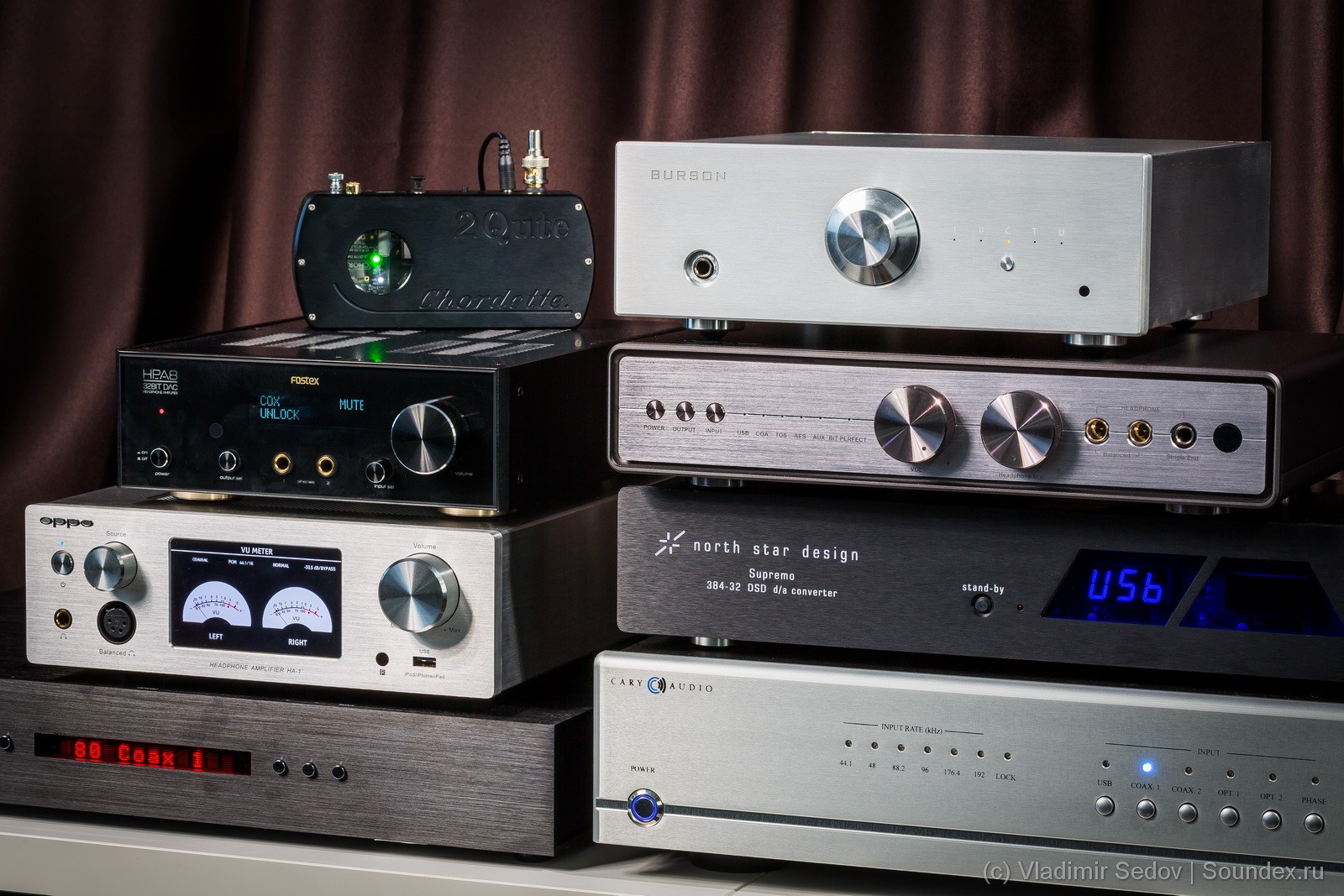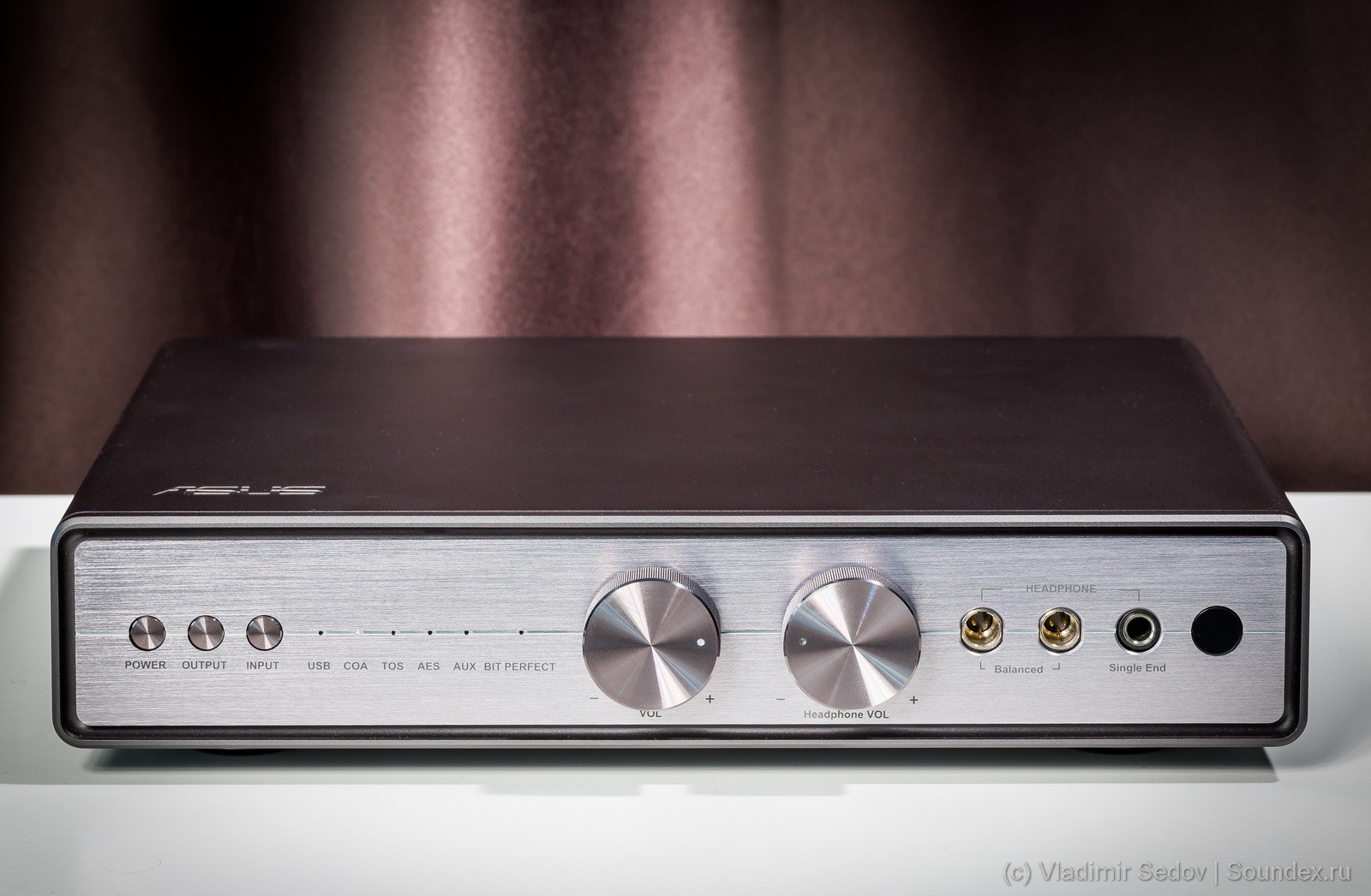There has long been a debate among good sound lovers about whether the difference between cables, sources and DACs is so well audible that it can be identified with our eyes closed. Or are we more influenced by brand promotion and personal preferences?
We have gathered 10 experts in the field of audio from our forum Soundex.ru. Many of them have been listening to music at home for decades, have assembled their systems from scratch, have listened to hundreds or even thousands of different components. And we have invited them to the showroom of the company. RoundAudio We deliberately did not limit ourselves to one price category of DACs and allowed ourselves such a large price spread. After all, the second question that worries many is how real the price that brands put up for their products is.
In order to completely eliminate personal preferences in music genres and avoid subjectivity, we used AudioDoctor FSQ 2006, a well-tested technique in our reviews, originally developed to test the sound in car audio, but later adapted for analysis of home audio systems.
Let us mention right away that this test is not the truth in the last instance, and perhaps its results are only suitable for our test system. Besides, it excludes undoubtedly important but very subjective parameters depending on the listener's mood, such as "musicality", "involvement", "emotionality" of the system.
For the test we used tracks No. 15 (setting the volume level to 86 dBA at the listening point), 9 (estimating the width of the formed stereo phase), 10 (estimating the scene depth and microdynamics transmission accuracy), 11 (estimating the attack, focus and localization), 12 (estimating the tonal balance and scene space transmission), 13 (estimating the sound at small levels, macro and microdynamics).
All devices were connected to the computer directly via USB using ASIO or WASAPI drivers in the first stage. In the second stage, listening was performed via M2Tech HiFace Evo converter via SPDIF. It should also be noted that during the testing unbalanced RCA outputs of the devices were used. And devices equipped with balanced XLR outputs in other conditions could have proved different.
The complete system for testing looked like this:
Source - Toshiba Qosmio G50-12L, Korg AudioGate 3.05.
DACs are the test object behind the screen.
The preamplifier is a passive transformer Django, retail price in Russia USD 2200.
The power amplifier is Burson Audio Timekeeper monoblocks.
Interblock cables - Tchernov Audio Ultimate.
Aktyna SCM Vortex SPK acoustic cables.
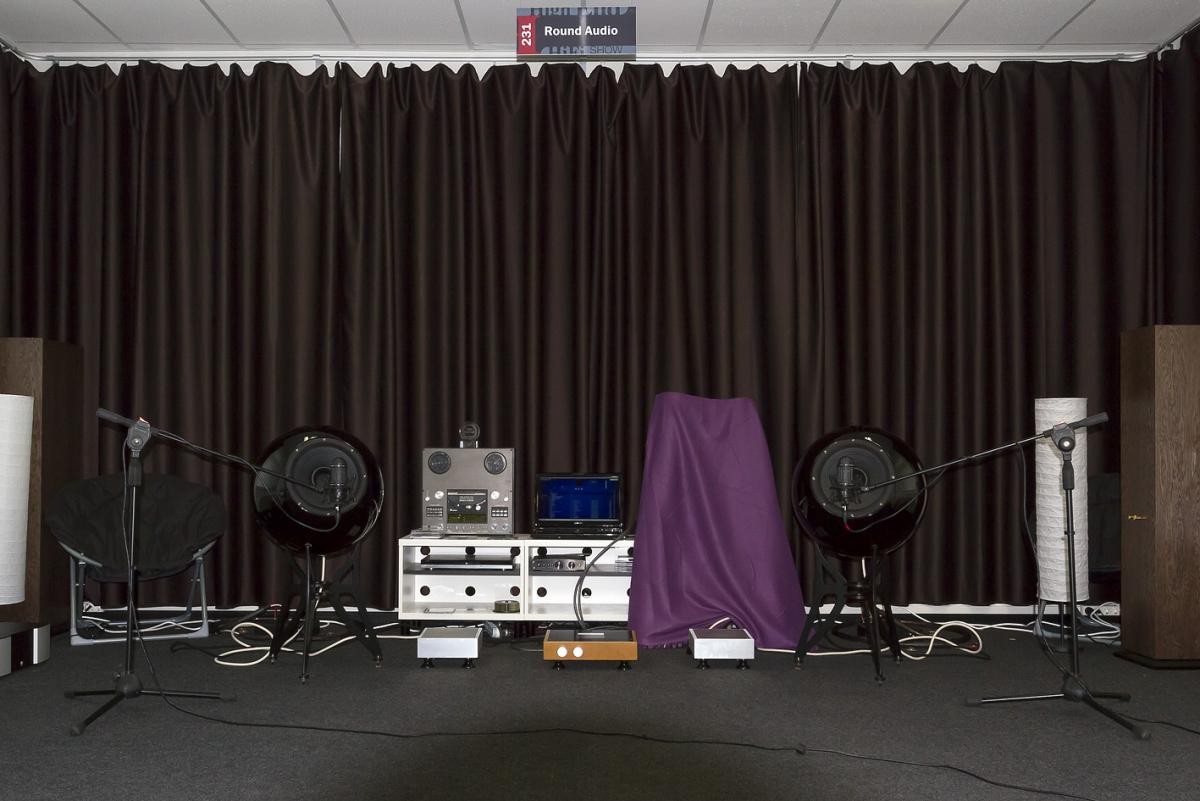
So, at first a little bit about the DACs themselves and their impressions of listening. At the end of the article there are the results and a little analysis.
ASUS Essence III
ASUS was the first IT manufacturer to pay such serious attention to the Hi-Fi industry, starting with the development of premium Essence series sound cards, which made it possible to turn an ordinary computer into a very decent sound source. However, the company did not stop and quickly mastered the production of external DACs. The top on this path was the flagship DAC ASUS Essence III.
There are two large volume control knobs on the front panel, one for level control at the line outputs and the other for headphone output.
The following connectors are available to connect to the audio source: asynchronous USB connector, linear RCA-stereo input, coaxial, optical, balanced AES/EBU from digital inputs, linear RCA and balanced XLR outputs are also available. A special toggle switch is provided, which allows you to mute the volume control and send a signal to the line output with a fixed level. The highlight of the model are balanced microXLR outputs for connecting Hi-End headphones.
Two ADI AD1955 chips are responsible for the digital-to-analog conversion, one per channel, in balance, using high-precision quartz oscillators (TCCO/TCXO) to achieve high dynamics and minimise jitter. The JRC MUSES 02 and ADI AD827SQ operational amplifiers provide high sound stability with minimal distortion. The device is equipped with two 24-position attenuators built on resistors with a tolerance of 0.1 %, which gives the optimal channel balance.
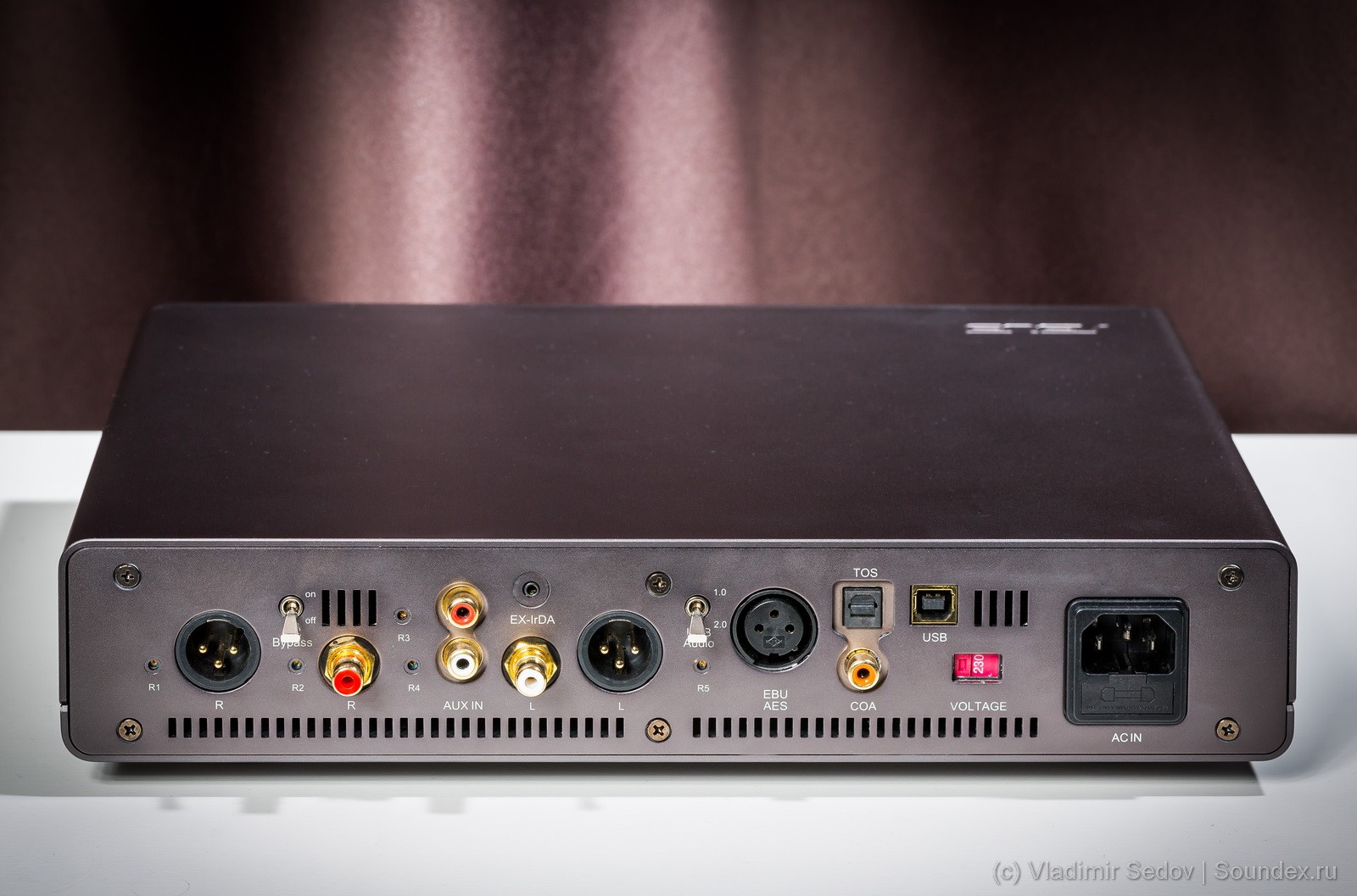
Circuits are built on the principle of "double mono". Analog and digital parts of the circuit, made on separate PCBs, are powered by autonomous stabilized power supply units. Voltage is supplied to the power supply units from a high power toroidal transformer. Smoothing the current is provided by WIMA capacitors.
Using ADI AD1955 chips, ASUS Essence III supports DSD playback at the hardware level, eliminating the need to convert the signal to PCM. A special toggle switch on the rear panel allows you to switch the USB input to USB 1.0 mode (work with a computer without drivers) or USB 2.0 mode (work with an ASIO driver). In the first case, the maximum sample rate is limited to 48 kHz. USB 2.0 mode supports PCM up to 192 kHz/24 bits and DSD64/128 streams. All device inputs support 24-bit/192 kHz sampling, which is an important advantage.
The ASUS Essence III can be used as a preamplifier and features a powerful built-in headphone amplifier built on TI LME49600 chips. Individual amplification modules are used for the balance outputs and 6.3mm outputs. The amplifier's capabilities allow even the most demanding Hi-End headphones to be used with impedances up to 600 ohms.
Essence III is equipped with a fairly simple and functional remote control, which allows you to turn on and off the device, switch inputs and outputs. The remote control also allows you to adjust the volume of the line output, attenuator which is motorized. When connecting the DAC to an amplifier with its own volume control, the adjustment can be disabled by a special toggle switch.
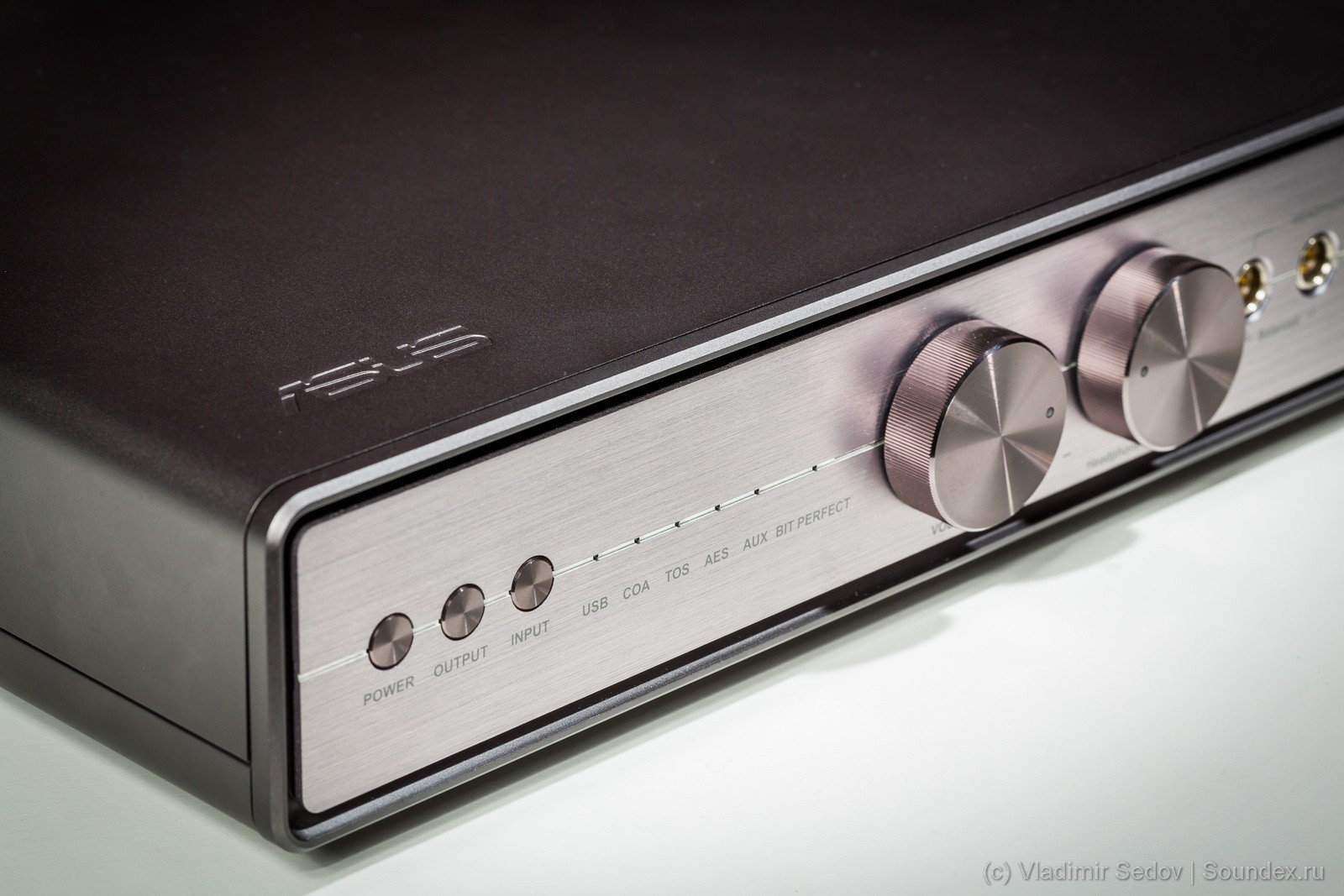
The impressions of the audition:
USB
Tonal balance is smooth. bass is deep, well articulated. the scene is continuous, and, on the test recordings, it is distinctly out of the loudspeaker base. the scene space and air are transmitted well. the detail is high, but not excessive. micro and macro dynamics are very good. the attack is good. focusing and localization in the horizontal plane is at least good. in the vertical plane is good. the height of the instruments corresponds to the natural height. sound images are not in any way associated with asce sound at low levels is very good, so...
SPDIF
In general, the sound of the device in this connection is similar to that of a USB connection, with some impairments in terms of bass depth and sound spatial characteristics.
Characteristics:
|
Model name |
ASUS Essence III |
|
Manufacturer's website |
asus.com |
|
Approximate cost |
165-170 thousand rubles |
|
Chip |
ADI AD1955 |
|
Key Technologies |
|
|
Overall dimensions |
322 x 71 x 228 mm |
|
Weight |
4 kg
|
Burson Audio Conductor Virtuoso 9018
The Australian company Burson Audio is well known to Russian audiophiles and has an excellent reputation for excellent sounding devices. One of the flagship models of the company was the device Burson Audio Conductor Virtuoso 9018, which combines a USB DAC, preamplifier and headphone amplifier.
the 9018 is made in a fairly solid aluminium case with a minimalist design. the case has an anti-resonance design. the case details are very carefully fitted, so it looks almost like a monolithic object. the case design effectively copes with the passive cooling function of the device, which allowed the manufacturer to eliminate the fan. the central place on the front panel is occupied by an impressive volume control knob with a very stylish LED indication. there is also an input selector switch.
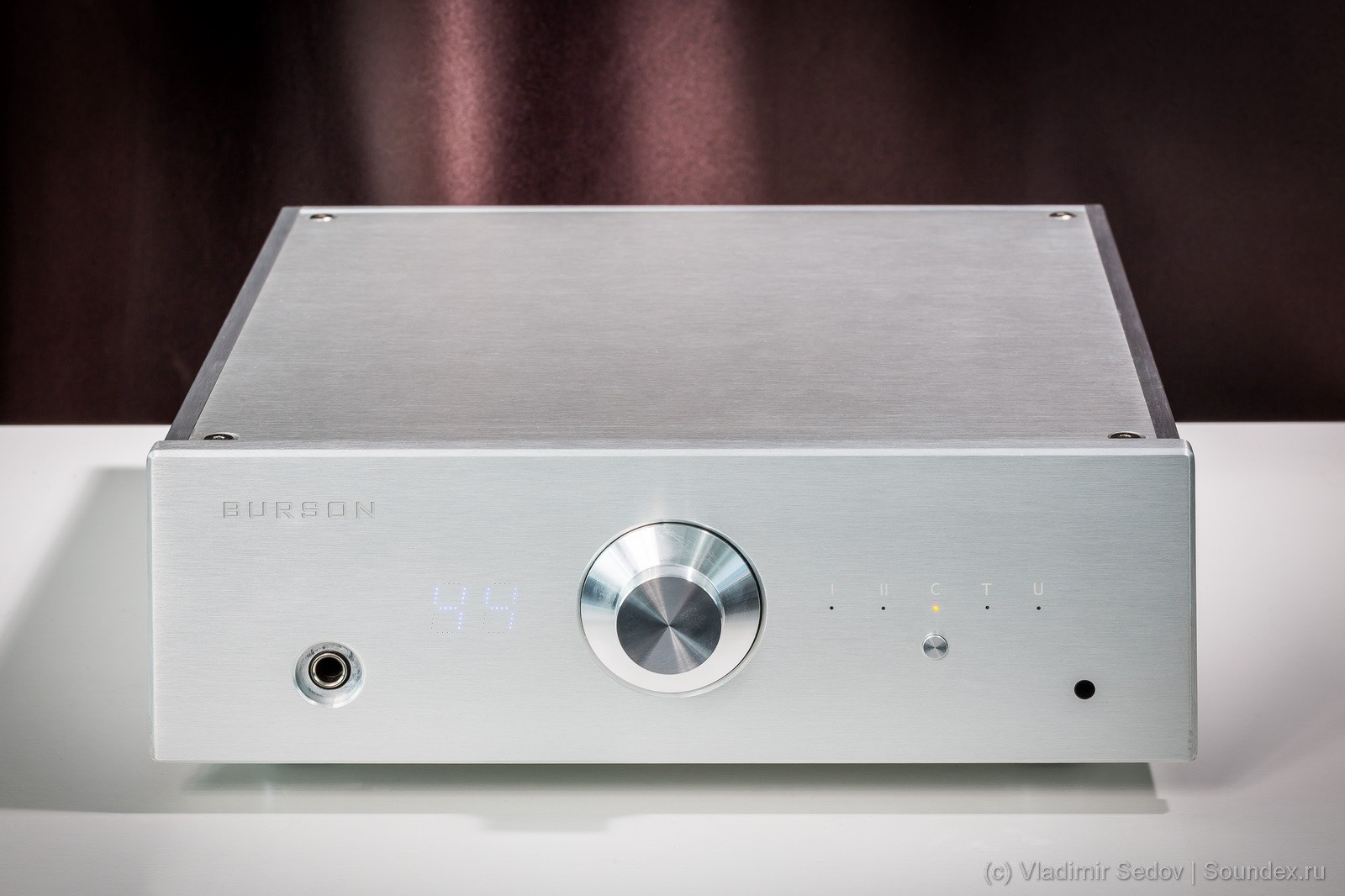
The device is equipped with Tenor TE8802 (24-bit/192 kHz) USB asynchronous interface and optical and coaxial inputs supporting a resolution of up to 32 bits/192 kHz. For analog switching the following are used: RCA input, headphone output (6.35 mm), DAC line output and adjustable preamplifier output.
The Conductor Virtuoso 9018 is based on the well-known and well-proven 32-bit ESS SABRE 32 Reference chip with Time Domain Jitter technology minimizing jitter levels, as well as versions of the model with a more budget Burr Brown PCM 1793 DAC chip. In both cases, the entire circuitry of the device is made on discrete elements using Mosfet transistors for each channel, allowing you to take full advantage of the chip.
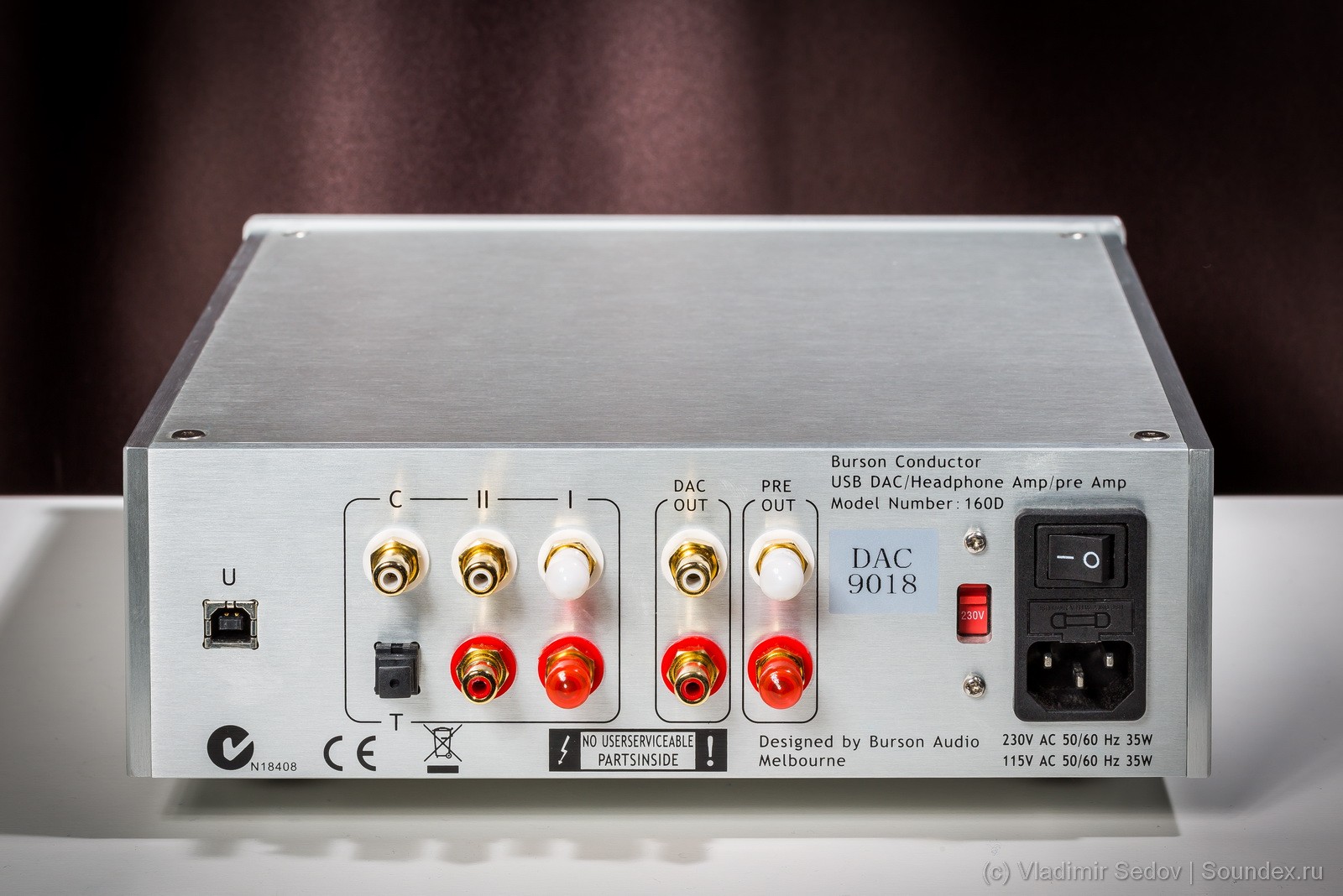
The device has a new 100-step volume control realized on TI PGA2310 chip. 120 dB dynamic range and non-linear distortion coefficient plus noise is 0.0004 %.
The design of Burson Audio Conductor Virtuoso 9018 uses a proprietary power supply unit that receives voltage from a toroidal transformer. The power supply unit uses capacitors with a total capacity of 32800 μF. This makes it possible to almost completely eliminate unwanted noise.
The unit performs perfectly with the preamplifier function, and the signal is fed from the amplification stage located up to the current amplification section, allowing you to take full advantage of the output stage on field-effect transistors. Burson Audio Conductor Virtuoso 9018 also has a built-in headphone amplifier, fully implemented on a discrete circuitry, and operates in pure Class A. It provides full control over any headphones.
An important feature of the model is the proprietary VOS (Variable Output Stage) with the possibility of changing the gain level, which is used when working in headphone amplifier and preamplifier mode. In the first case, thanks to the VOS stage, the device confidently works with any headphones, providing them with power supply from 0.18 to 4 W per channel. When working in preamplifier mode it is possible to set the gain level from 7 to 18 dB, which allows you to effectively work with the terminals of any power.
Burson Audio Conductor Virtuoso 9018 has a handy miniature aluminium remote control that allows you to mute, switch tracks and adjust the volume.
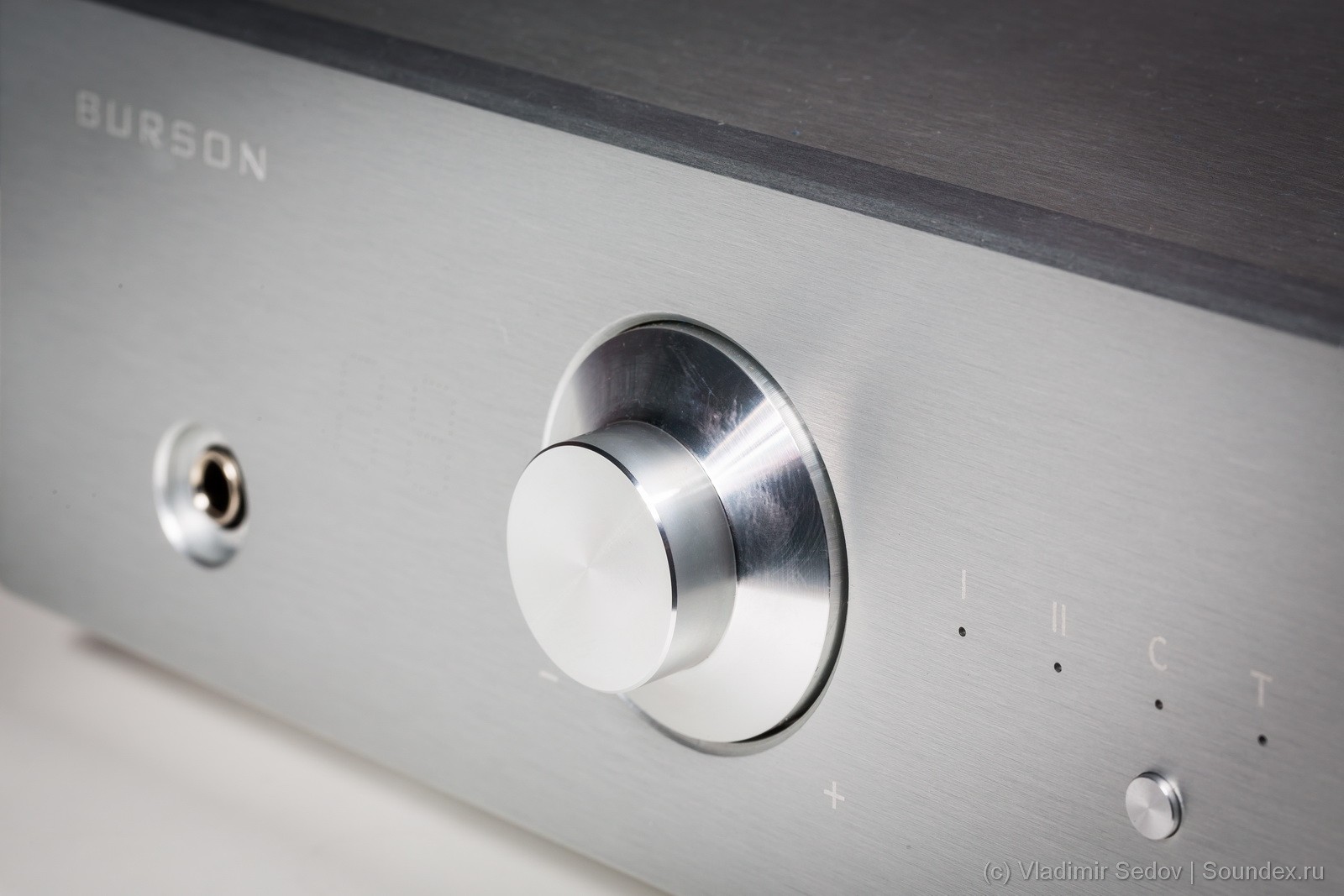
The impressions of the audition:
USB
Tonal balance is generally flat, with a slight accent in the bass area. The bass is deep, the articulation is satisfactory. The scene is continuous, and, on the test recordings, goes beyond the loudspeaker base. The space and air of the scene is transmitted well. The detail is generally high. Micro and macro dynamics are good. The attack is very good. The focus and localization in the horizontal plane is good. In the vertical plane is good. The height of the instruments corresponds to the natural one. Sound images are not associated with the speaker. Sound at low levels is good.
SPDIF
Sound retains the basic features of USB connectivity, with noticeable improvements in bass articulation and spatial sound characteristics (localization and focus).
Characteristics:
|
Model name |
Burson Audio Conductor Virtuoso 9018 |
|
Manufacturer's website |
bursonaudio.com |
|
Approximate cost |
100-105 thousand rubles |
|
Chip |
ESS 9018 DAC |
|
Key Technologies |
|
|
Overall dimensions |
80 × 265 × 255 mm |
|
Weight |
6 kg
|
Cary Audio DAC100
Company Cary Audio has been based in 1989 in the USA. Among audiophiles it has deserved recognition thanks to wide assortment of high-quality tube amplifiers which for a long time remained the basic kind of production of a brand. In an epoch of digital technologies the company also has found the worthy place in the market, becoming one of large manufacturers of multichannel processors and the DACs possessing high characteristics. The line of the audiophilic production which is let out on the advanced technologies, is called Classic. One of bright representatives of this line I
The device is made in a full-size steel case 44 centimeters wide. The thick front panel is made of silver aluminum. There are two lines of LED indication, a number of buttons for selecting inputs and a special button responsible for phase inversion of the signal. The device looks simple and solid.
Switching is carried out using five switchable input connectors, including 4 SPDIF digital inputs (2 coaxial and 2 Toslink) and a USB input. The signal is output to an analogue RCA output with a gold-plated connector or to a balanced XLR.
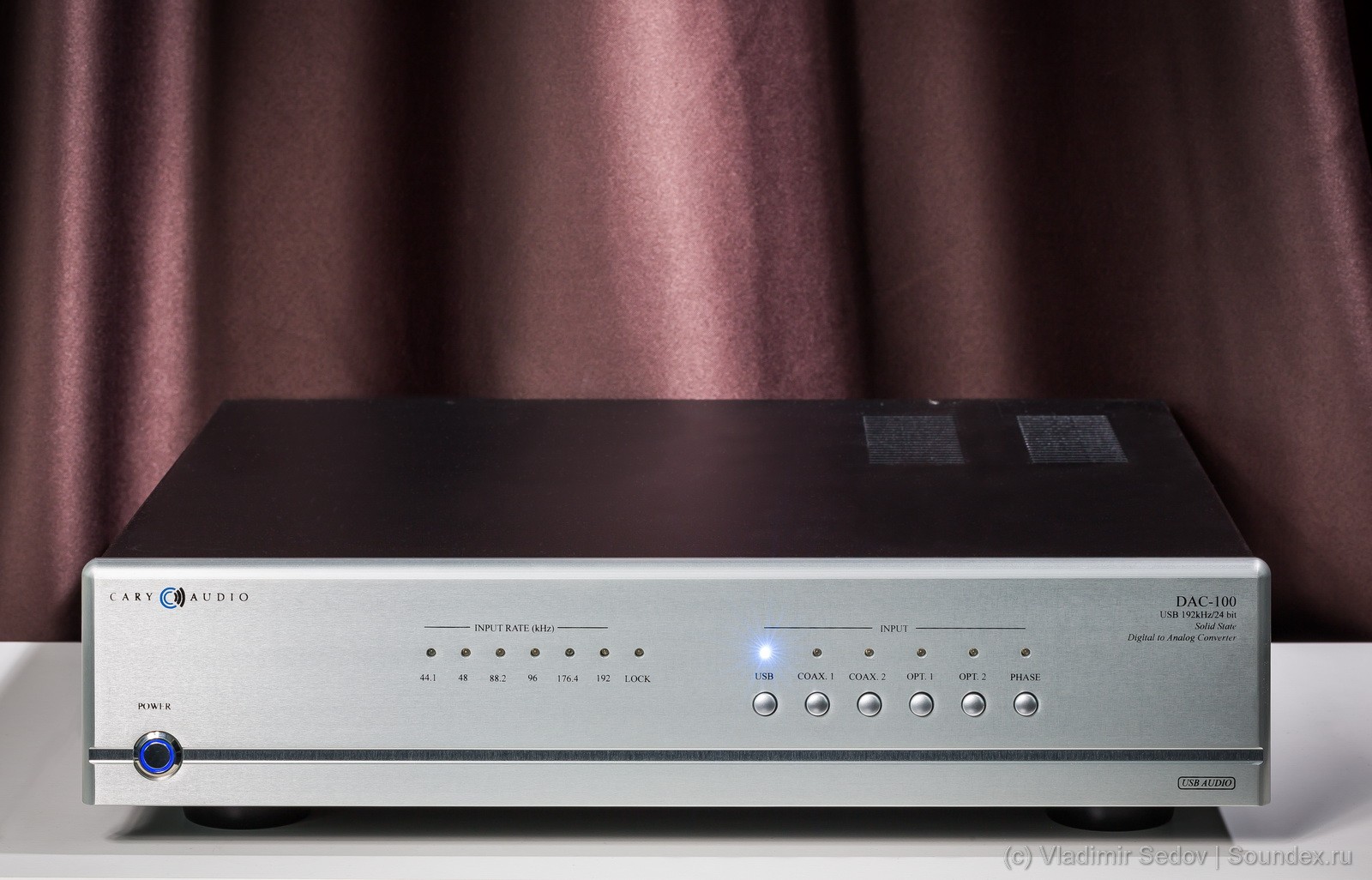
Two ESS Sabre ES9023 balance chips are responsible for the digital-to-analogue conversion in the Cary Audio DAC100 circuit. This chip has proven itself in high-end digital technology, providing accurate sound with minimal noise and distortion. The circuitry is made without any general feedback. The XLR sockets with gold-plated connectors have a symmetrical line output, eliminating the need for the user to artificially create a balance output using multiple operating amplifiers.
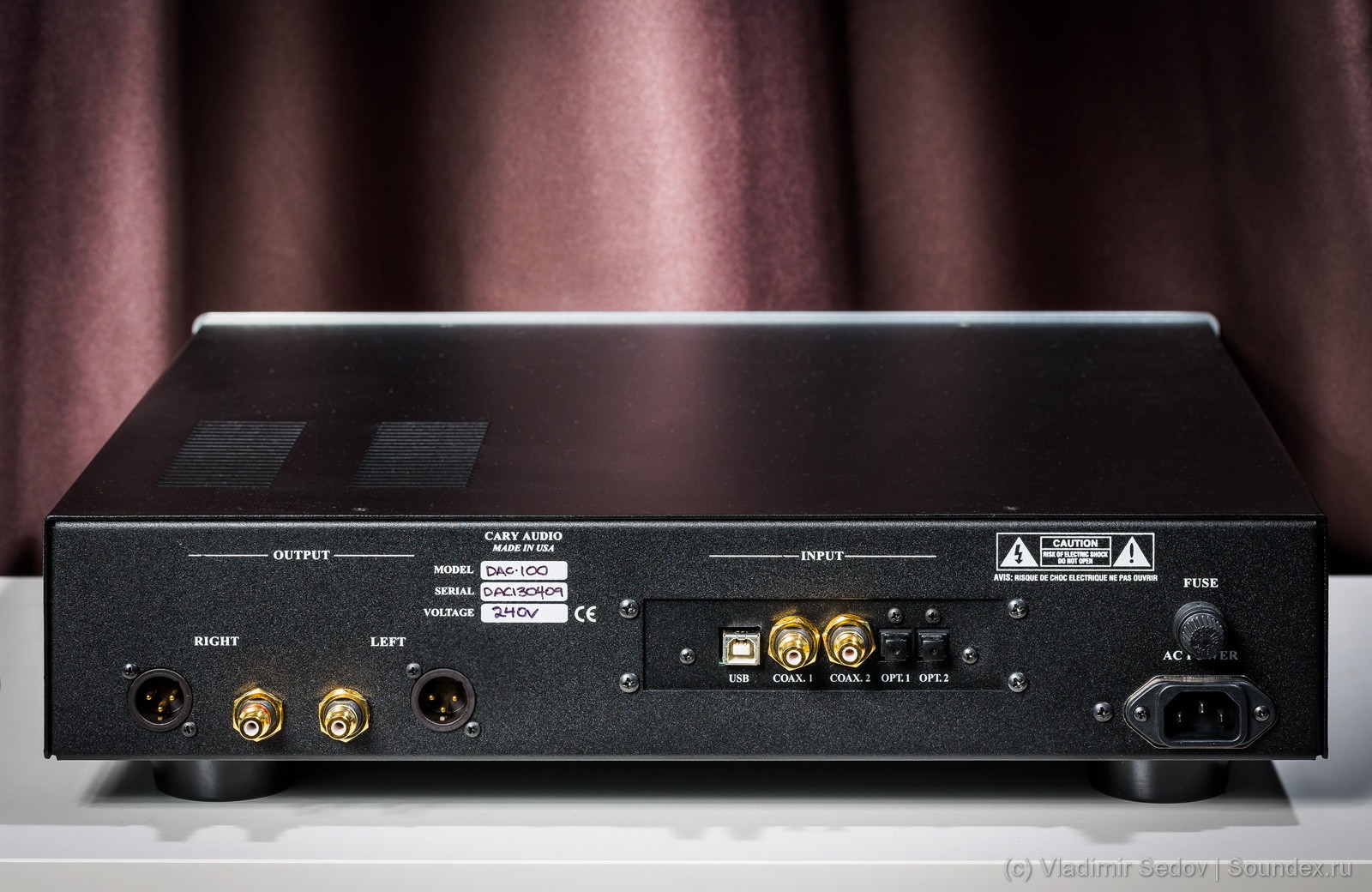
Coaxial and optical inputs are received at the Wolfson WM8805 Input Receiver, which supports 192 kHz sampling rates for SPDIF and 96 kHz for Toslink. The USB input serves the powerful XMOS processor, which provides asynchronous digital stream processing up to 24 bits/192 kHz. The processor has high performance and effectively reduces jitter. The desired input can be selected using a button on the front panel of the device, with an LED display showing the input frequency.
Considerable attention has been paid by the manufacturer to the construction of an effective power supply circuit for the device. The digital and analog parts of the circuit are powered by a separate toroidal transformer, while the transformer feeding the analogue path is protected by a Faraday screen, which allows to get rid of electrical interference and external noise.
An interesting feature of the device is the possibility of phase inversion of the signal. It can be activated by pressing a special button on the front panel. As a result, any phase is turned 180 degrees. This function will be useful when listening to phonograms with the phase inverted during recording.
The Cary Audio DAC100 digital to analogue converter is an effective device for playing high quality music files from your computer's hard drive and can also be used to improve the sound quality of any digital source.
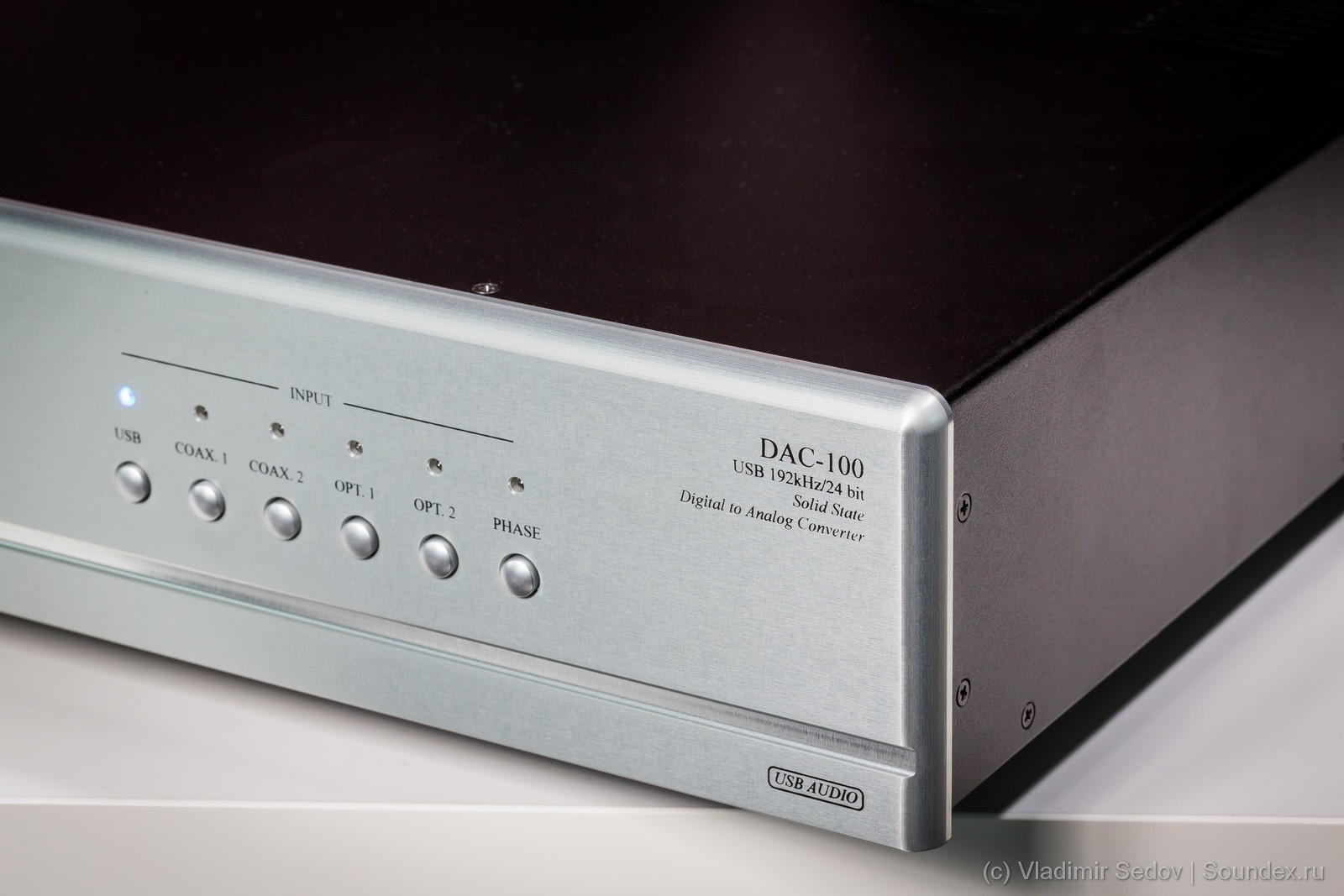
The impressions of the audition:
USB
The tonal balance is generally flat, the tweeter area is slightly softened. The bass is deep, well articulated. The scene is continuous, and, on the test recordings, the space and air in the scene are transmitted at least very well. The detail is high. Micro and macro dynamics are very good. The attack is very good. The focus and localization in the horizontal plane is very good. The vertical plane is very good. The height of the instruments corresponds to the natural height. Sound images are not associated with the speaker in any way.
SPDIF
Changing the connection has not revealed any significant changes in the sound character. The device sounds equally well in both USB and SPDIF.
Characteristics:
|
Model name |
Cary Audio DAC100 |
|
Manufacturer's website |
caryaudio.com |
|
Approximate cost |
195 thousand rubles |
|
Chip |
ESS Sabre ES9023 |
|
Key Technologies |
|
|
Overall dimensions |
89 x 440 x 395 mm |
|
Weight |
9.5 kg
|
Chord 2Qute
Британская компания Chord Electronics уже достаточно давно практикует изготовление компактных аудиофильских устройств в оригинальном дизайне. Первым шагом в этом направлении стало создание серии Choral, в которой была применена особая система вертикальной компоновки электроники, позволяющая сделать полноценные Hi-Fi устройства по-настоящему компактными. Однако с появлением серии Chordette компания смогла превзойти собственные достижения. Наиболее знаковыми моделями этой серии стали усилитель для наушников/ЦАП Hugo и ЦАП Qute Ex. Однако уже в 2015 году компания представила новый флагман Chord 2Qute, полученный в результате обширной модернизации обоих этих устройств, и объединяющий в себе функциональные и технологические преимущества.
Компактный ЦАП Chord 2Qute выполнен в миниатюрном алюминиевом корпусе габаритами всего 160x70x40 мм. Детали корпуса тщательно подогнаны. Благодаря эому устройство производит впечатление цельного бруска красивого серебристого металла. Дизайн выполнен полностью в духе Chord. Единственным элементом на передней панели является традиционный иллюминатор, за которым открывается центральный чип и материнская плата. При включении устройства внутреннее пространство подсвечивается красивым зеленоватым свечением.
Chord 2Qute имеет коаксиальный, оптический, USB входы и выходы. USB вход второго класса имеет гальваническую изоляцию.
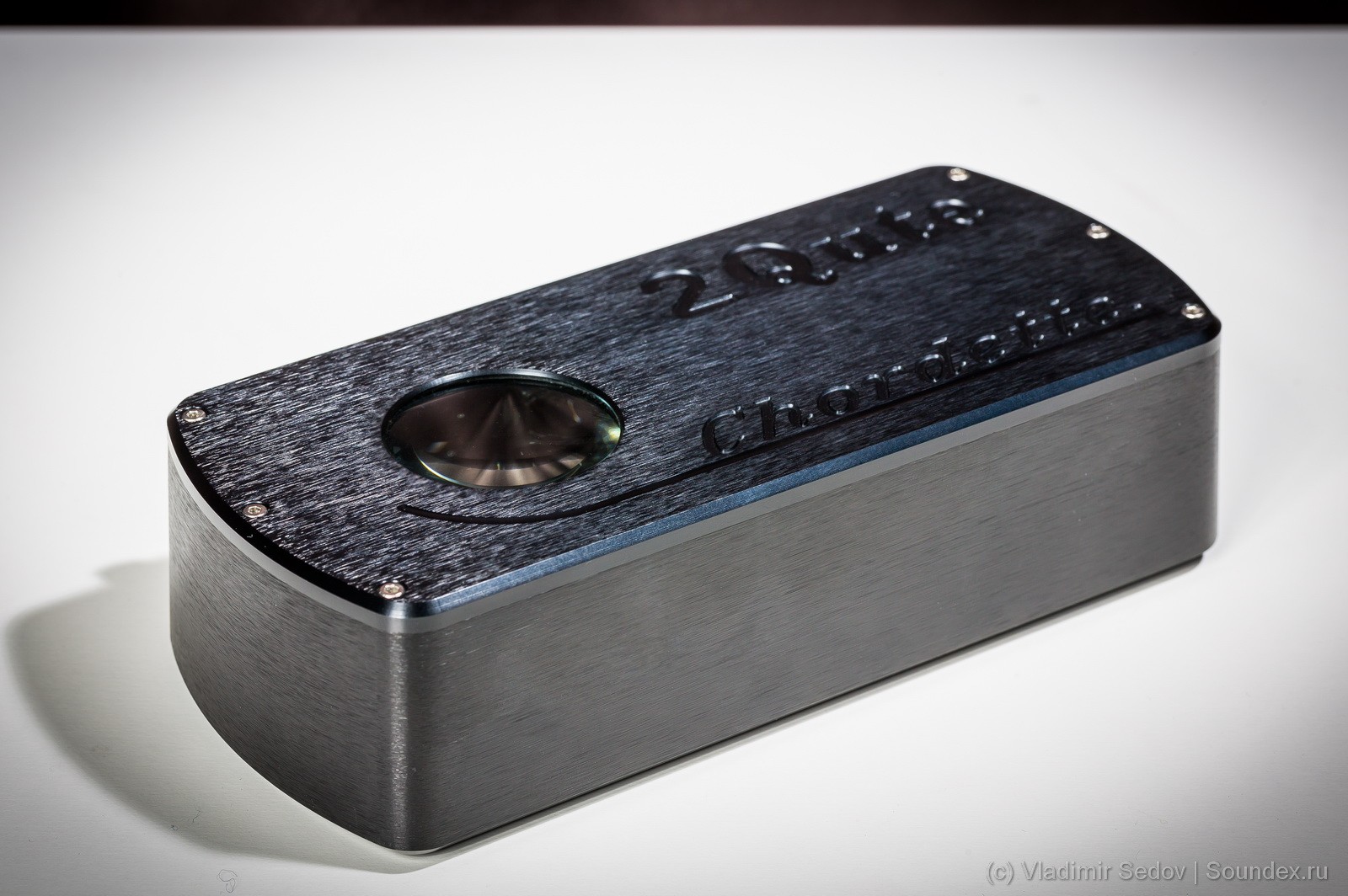
Устройство оснащено мощным чипом Spartan 6 FPGA, позаимствованным у предыдущей модели Hugo. Микросхема, выполненная по технологии вентильно-программируемых матриц, обеспечивает очень чистое звучание с минимальным уровнем искажений, который составляет всего 0,0003 %. Показатель перекрестных помех составляет всего 126 дБ на 1 кГц. При этом возможности используемого чипа позволяют воспроизводить файлы высокого разрешения с обеспечением качественного и точного звучания. При воспроизведении сигнала через USB и коаксиальный вход поддерживается воспроизведение файлов до 32-бит/384 кГц и DSD128, на оптическом входе — до 24-бит/192 кГц и DSD64 на всех входах. Задействовать нужный вход можно при помощи удобного переключателя, которым оснащено устройство. Имеется также и индикация действующего источника и частоты дискретизации при помощи подсветки, что делает работу с Chord 2Qute более удобной для пользователя.
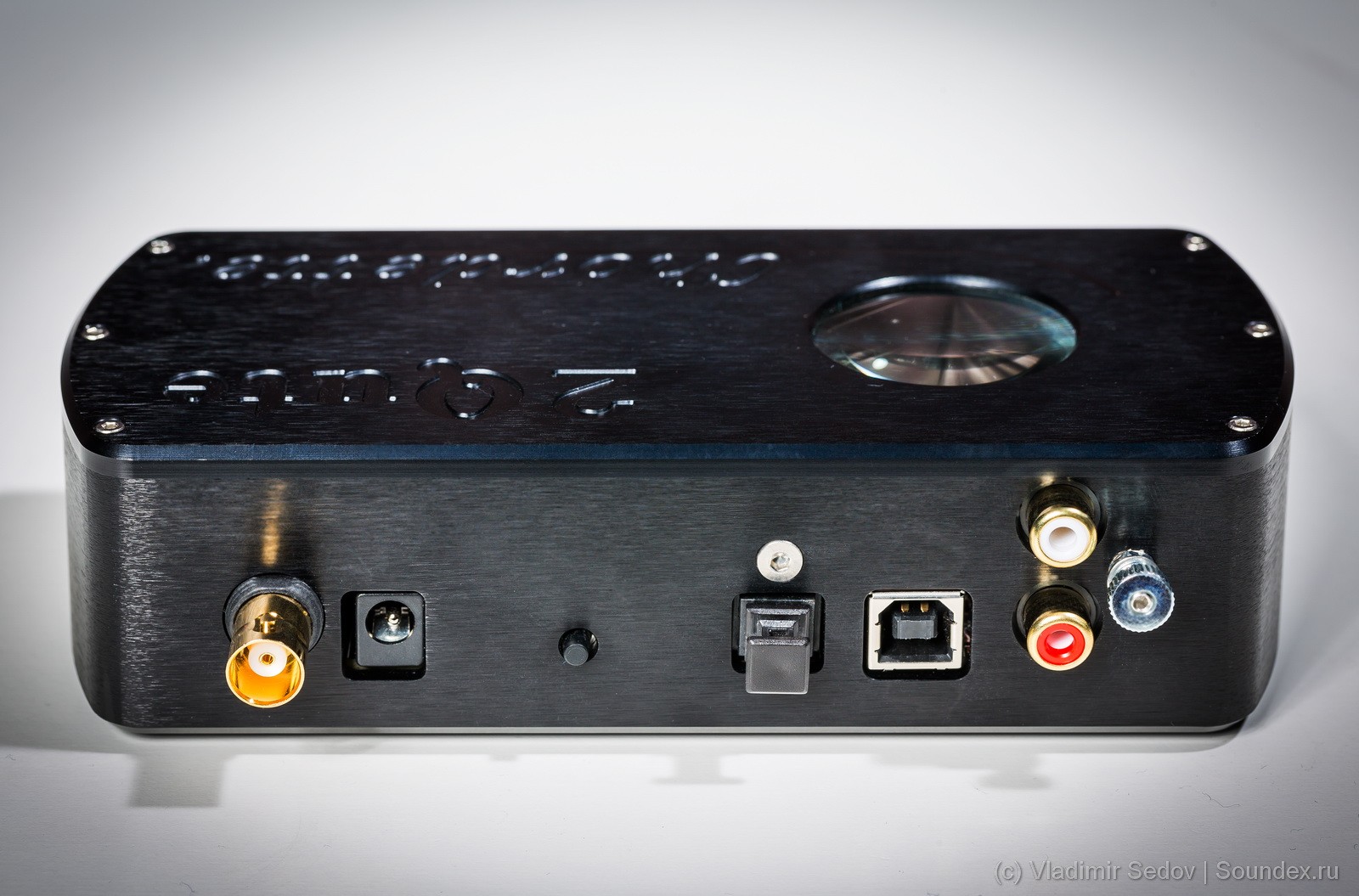
Особенно поработали разработчики над USB входом, который имеет 2 класс, обеспечивая максимальную скорость передачи данных разрешением до 384 кГц. Применение гальванической изоляции USB входа позволило существенно улучшить акустические характеристики устройства. USB вход поддерживает работу с мобильными устройствами iOS и Android. Также поддерживается совместимость с Windows – для работы на ПК необходимо установить фирменный драйвер, который имеется на идущем в комплекте с устройством диске, а также доступен для скачивания на сайте производителя. В частности, доступны драйвера для Windows 7 и Windows 8.
Для создания Chord 2Qute была существенно переработана традиционная для устройств серии Chordette печатная плата. Благодаря этому новый ЦАП получил производительность и другие ключевые характеристики, свойственные модели Hugo. При этом, в отличие от этой модели, Chord 2Qute предназначен, скорее, для домашнего использования. В связи с этим из его арсенала были исключены некоторые «мобильные» функции, свойственные для Hugo. В том числе он был избавлен от регулятора громкости и встроенной батареи питания.
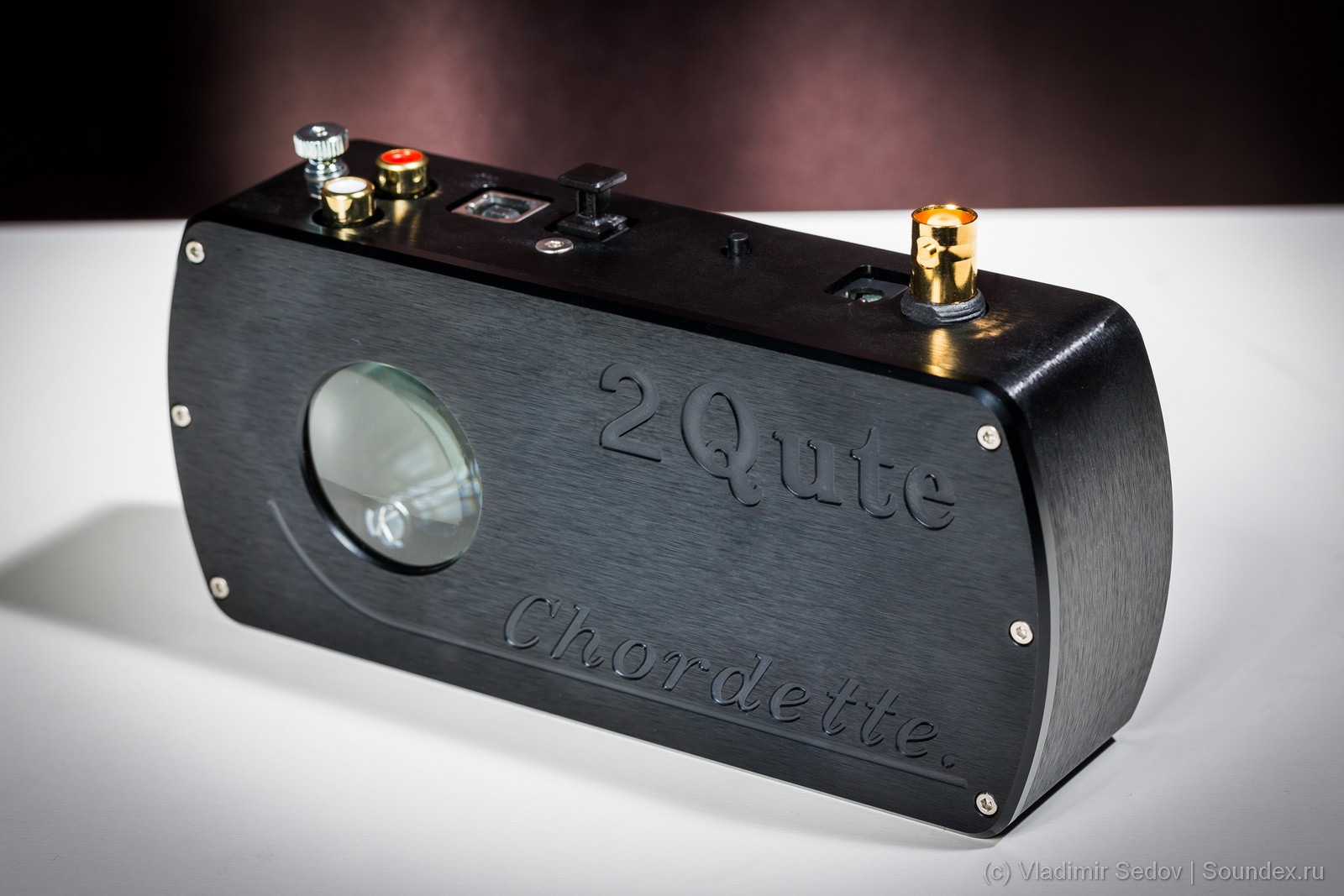
The impressions of the audition:
USB
Тональный баланс в целом ровный. Бас хорошо артикулированный. Сцена непрерывна, но на тестовых записях практически не выходит за пределы базы громкоговорителей. Пространство и воздух сцены передаются удовлетворительно. Детальность высокая. Микродинамика — хорошо, макродинамика — удовлетворительно. Атака — хорошо. Фокусировка и локализация в горизонтальной плоскости — хорошо. В вертикальной плоскости — удовлетворительно. Высота расположения инструментов чуть выше натуральной. Звуковые образы не ассоциируются с АС. Звучание на малых уровнях хорошее, тембры инструментов достоверны.
SPDIF
Подключение данного типа дает существенный прирост качества звучания по сравнению с подключением по USB. Особенно заметны улучшения в части глубины баса, микро/макродинамики и пространственных характеристик звучания (высота расположения инструментов, локализация и фокусировка).
Characteristics:
|
Model name |
Chord 2Qute |
|
Manufacturer's website |
|
|
Approximate cost |
100 тысяч рублей |
|
Chip |
Spartan 6 FPGA |
|
Key Technologies |
|
|
Overall dimensions |
160x70x40 мм |
|
Weight |
0,4 кг
|
Densen DenDAC 50
Датская компания Densen хорошо известна ценителям высокого звука. Большой успех получили виниловые проигрыватели, усилители и другие устройства модели. ЦАПы до недавнего времени не были представлены в модельном ряду Densen. При этом компания выпустила первый ЦАП еще в 1994 году, но предназначался для другого бренда. В дальнейшем компанией также выпускались ЦАПы по заказу других компаний. Первым полноразмерным ЦАП компании, выпущенным под собственным брендом, стал Densen DenDAC 50.
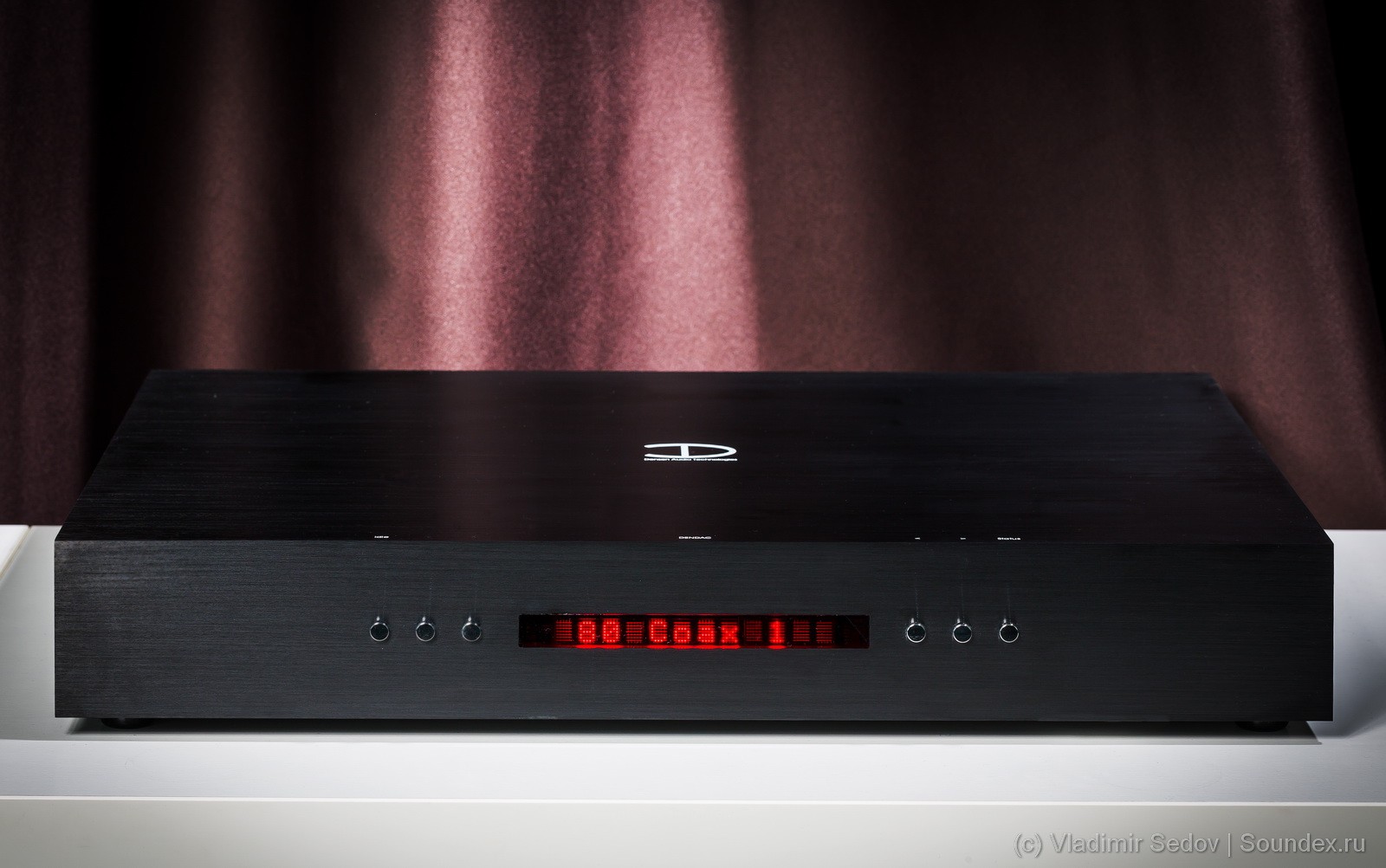
ЦАП Densen DenDAC 50 имеет лаконичный и стильный дизайн. Детали массивного металлического корпуса подогнаны настолько четко, что он производит впечатление монолита. Корпус может быть выполнен в серебристом или черном цвете. На лицевой панели расположено шесть кнопок управления (по три с каждой стороны), между которыми находится узкий красный монохромный дисплей с яркой и красивой индикацией. Устройство имеет два коаксиальных SPDIF входа, два входа Toslink, и один вход USB 2.0. Для подключения ЦАП к предусилителю имеются RCA и баласный выходы.
Принципиальным отличием Densen DenDAC является применение полностью аналогового каскада предварительного усиления класса A без отрицательной обратной связи, что позволило отказаться от традиционного для современных ЦАП цифровых регуляторов громкости. Благодаря этому решению сохранен высокий уровень качества звучания на малых уровнях громкости. К регулируемому выходу подключен 200-шаговый регулятор громкости устройства контролируется микропроцессором.
 Преобразование сигнала осуществляется 24-битный ЦАП, помещенный в экранированную коробку. Это обеспечивает необходимую его защиту от цифровых помех на аналоговом каскаде. Дополнительное экранирование и оптимизацию прохождения сигнала по тракту обеспечивает четырехслойная печатная плата с тефлоновым покрытием, на которой построена цифровая часть.
Преобразование сигнала осуществляется 24-битный ЦАП, помещенный в экранированную коробку. Это обеспечивает необходимую его защиту от цифровых помех на аналоговом каскаде. Дополнительное экранирование и оптимизацию прохождения сигнала по тракту обеспечивает четырехслойная печатная плата с тефлоновым покрытием, на которой построена цифровая часть.
В конструкции Densen DenDAC 50 применяется специально разработанный для этой модели оптимизированный блок питания. Его «сердцем» являются два заказных тороидальных трансформатора, каждый из которых имеет по четыре выхода. От этих трансформаторов запитано 5 выпрямительных мостов с общей емкостью 50 000 мФ. Кроме этого, предусмотрено 14 отдельных регуляторов, от которых запитаны наиболее чувствительные цепи питания. Это позволяет практически полностью исключить помехи, которые могут возникать при их работе.
Разработчиками Densen DenDAC 50 предусмотрена возможность модернизации устройства. В частности, аппарат имеет специальный внутренний порт, который можно будет использовать для установки платы с перспективными цифровыми разъемами, который могут быть разработаны в будущем. Благодаря этому ЦАП будет использовать самые актуальный цифровые входы, имеющиеся на рынке, даже через несколько лет. Также этот порт можно задействовать для подключения платы модуля Wi-Fi, который компания Densen планирует представить в ближайшем будущем.
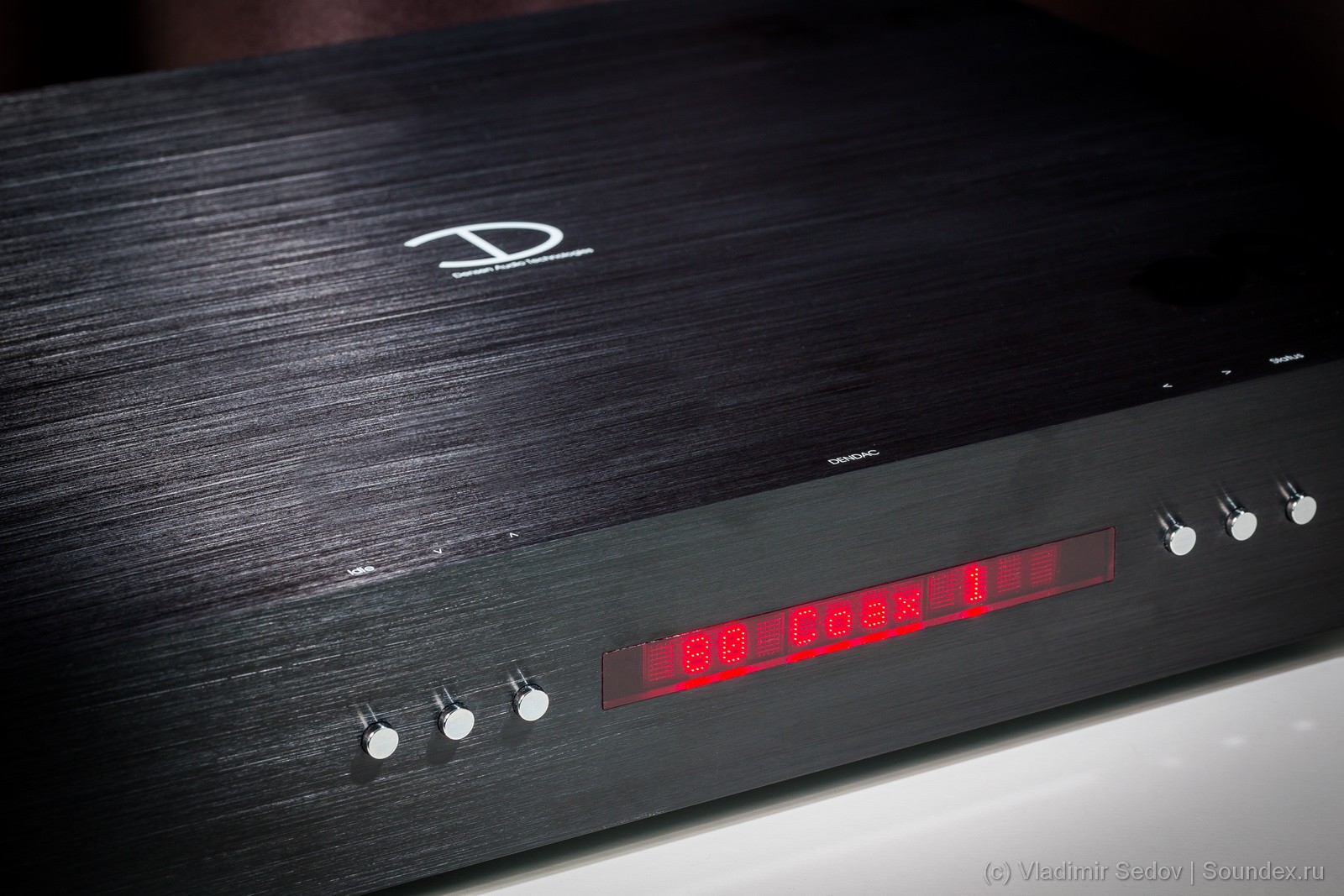
The impressions of the audition:
USB
Тональный баланс в целом ровный. Бас хорошо артикулированный. Сцена непрерывна, но на тестовых записях практически не выходит за пределы базы громкоговорителей. Пространство и воздух сцены передаются удовлетворительно. Детальность высокая. Микродинамика — хорошо, макродинамика — удовлетворительно. Атака -удовлетворительно. Фокусировка и локализация в горизонтальной плоскости — хорошо. В вертикальной плоскости — удовлетворительно. Высота расположения инструментов чуть выше натуральной. Звуковые образы не ассоциируются с АС. Звучание на малых уровнях хорошее, тембры инструментов достоверны.
SPDIF
Подключение данного типа дает радикально изменяет качество звучания устройства в лучшую сторону. Тональный баланс ровный. Бас глубокий, хорошо артикулированный. Сцена непрерывна, и на тестовых записях заметно выходит за пределы базы громкоговорителей. Пространство и воздух сцены передаются как минимум очень хорошо. Детальность высокая, но не чрезмерная. Микродинамика — очень хорошо, макродинамика — отлично. Атака — отлично. Фокусировка и локализация в горизонтальной плоскости — отлично. В вертикальной плоскости — очень хорошо. Высота расположения инструментов натруальная. Звуковые образы никак не ассоциируются с АС. Звучание на малых уровнях очень хорошее, тембры инструментов достоверны.
Characteristics:
|
Model name |
Densen DenDAC |
|
Manufacturer's website |
densen.dk |
|
Approximate cost |
250 тысяч рублей |
|
Chip |
|
|
Key Technologies |
|
|
Overall dimensions |
440 x 320 x 64 мм |
|
Weight |
14 кг
|
Fostex HP-A8
Японская компания Fostex, основанная в Токио в 1973 году уже давно заслужила репутацию одного из ведущих производителей высококлассных акустических систем и наушников. С наступлением эпохи цифрового звука компания смогла предложить аудиофилам широкий выбор отлично звучащих устройств. Одной из флагманских моделей таких устройств сегодня является цифроаналоговый преобразователь Fostex HP-A8, который помимо непосредственно выполнения функции ЦАП может использоваться в качестве дискретного усилителя для наушников и стереофонического предусилителя.
Fostex HP-A8 имеет массивный высокий корпус половинной ширины из высококачественного алюминиевого сплава. Устройство смотрится солидно и внушительно, имеет ощутимый вес. Эффектным украшением лицевой панели является матричный дисплей, выполненный в бледно-голубом оттенке. Благодаря высокой яркости и контрастности дисплей обеспечивает хорошую информативность. Предусматривается 5 цифровых входов (2 TosLink, SPDIF, AES/EBU, USB) и два выхода (TosLink и SPDIF). Также на задней панели имеются аналоговые небалансные (RCA) входы/выходы. На лицевой панели размещены два выхода для подключения наушников 6,3 мм. Предусмотрен также слот для SD, который может использоваться для обновления прошивки устройства, а также для воспроизведения DSD аудио.
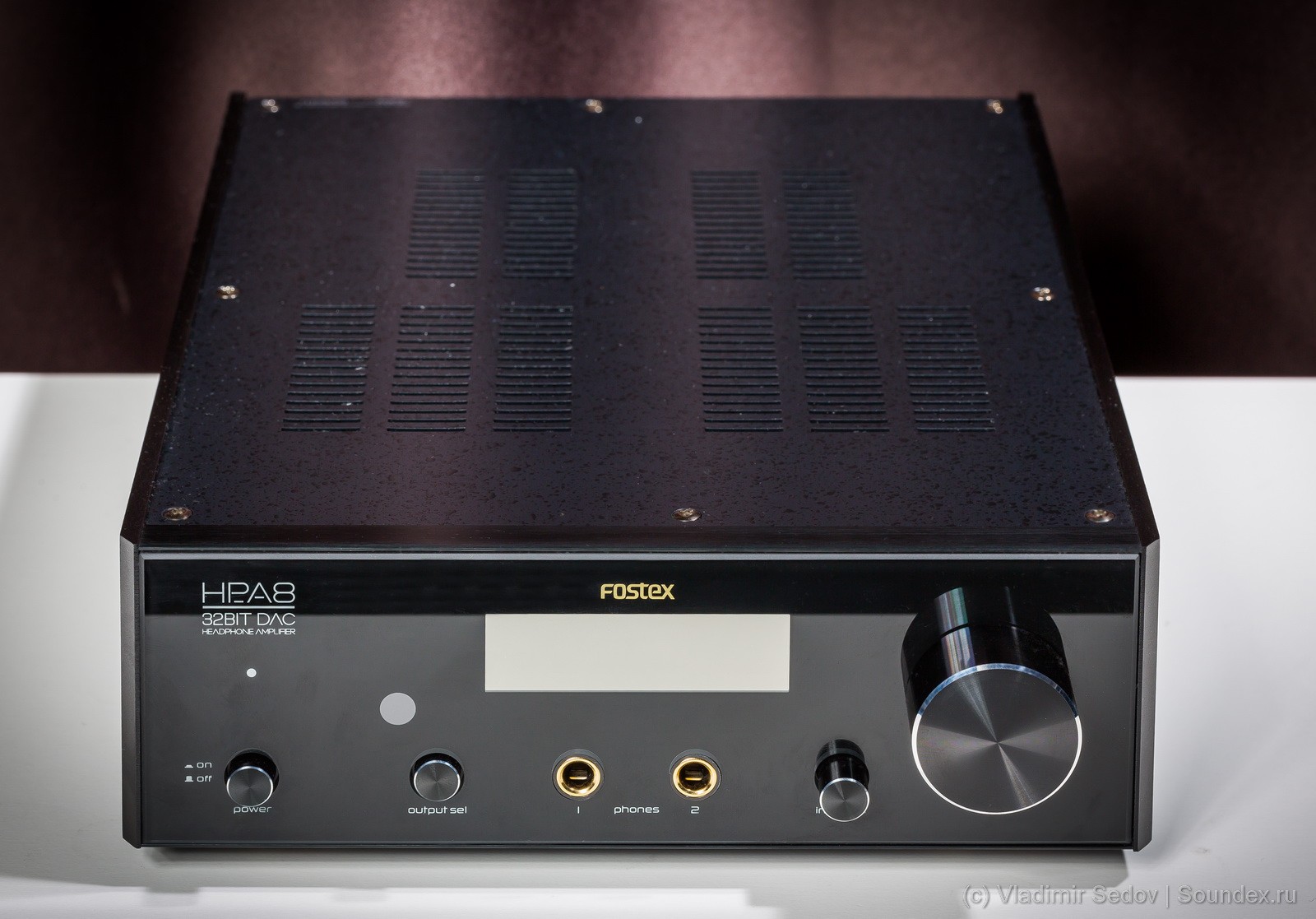
За цифроаналоговое преобразование отвечает 32-битный чип AK4399 от компании AsahiKaseiMicrodevices, который поддерживает воспроизведение аудиофайлов в качестве до 32 бит / 192 кГц. Кроме стандартного фильтра «sharproll-of» может использоваться специально разработанный AsahiKaseiMicrodevices фильтр «minimumdelay», с помощью которого эффективно устраняется пре-эхо. Помимо самого чипа и электронного регулятора громкости, схемотехника строится исключительно на дискретных элементах. Кварцевый термокомпенсированный генератор TCXO обеспечивает передачу потока по USB в асинхронном режиме с высокой точностью и минимальным уровнем помех. Для подключения по другим входам предусмотрена возможность выбора между внешним и внутренним генераторами частоты.
Очень тщательно подобрана производителем и схема питания устройства. Она строится на основе тороидального трансформатора высокой мощности. Благодаря этому удается минимизировать помехи, возникающие в этой части, и достичь высокой точности сигнала.
Characteristics:
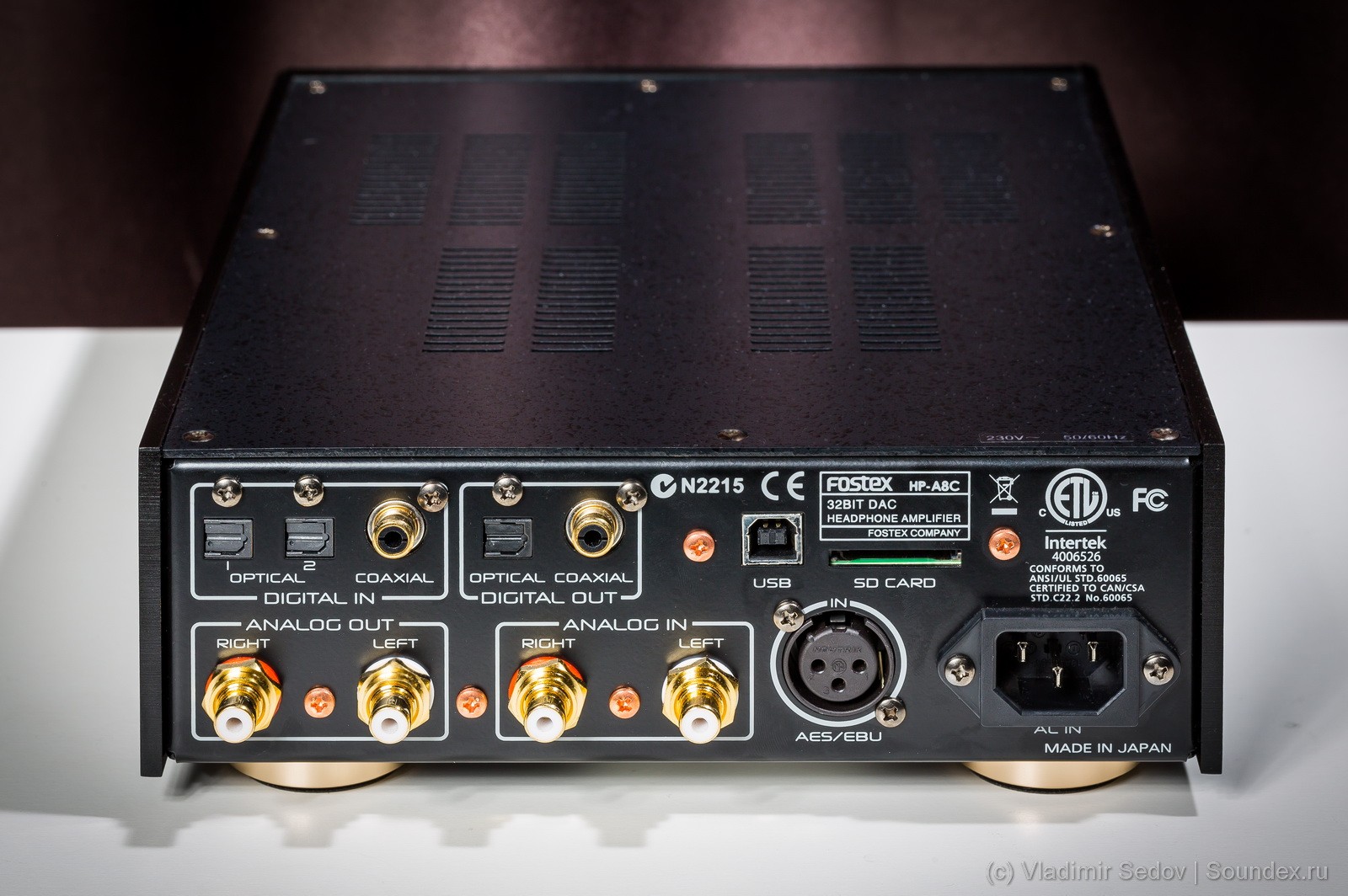
Fostex HP-A8 может использоваться в качестве предварительного усилителя. В этом режиме устройство позволяет обеспечить высокое качество звучания музыкальных файлов, воспроизводимых практически с любого цифрового источника. Кроме того, Fostex HP-A8 имеет встроенный аналоговый усилитель для наушников, построенный полностью на дискретных элементах. Усилитель отличается высоким уровнем выходной мощности при минимальных искажениях сигнала. Он работает с изменяющимся импедансом сигнала в пределах 16-600 Ом. При этом имеется 24 пресета коэффициента усиления, что позволяет обеспечить уверенную работу с головными телефонами, обладающими практически любыми характеристиками. Схема усилителя позволяет добиться высокой нейтральности и с максимальной полнотой раскрыть характерные особенности наушников. Усилитель может подавать сигнал сразу на два выхода 6,3 мм для головных телефонов.
Для удобной работы с устройством можно использовать не только элементы управления на корпусе, но и достаточно функциональный пульт ДУ. Пульт выполнен в алюминиевом корпусе и дает все возможности для полноценного управления. Недоступным с его помощью остается только переключение используемых входов.
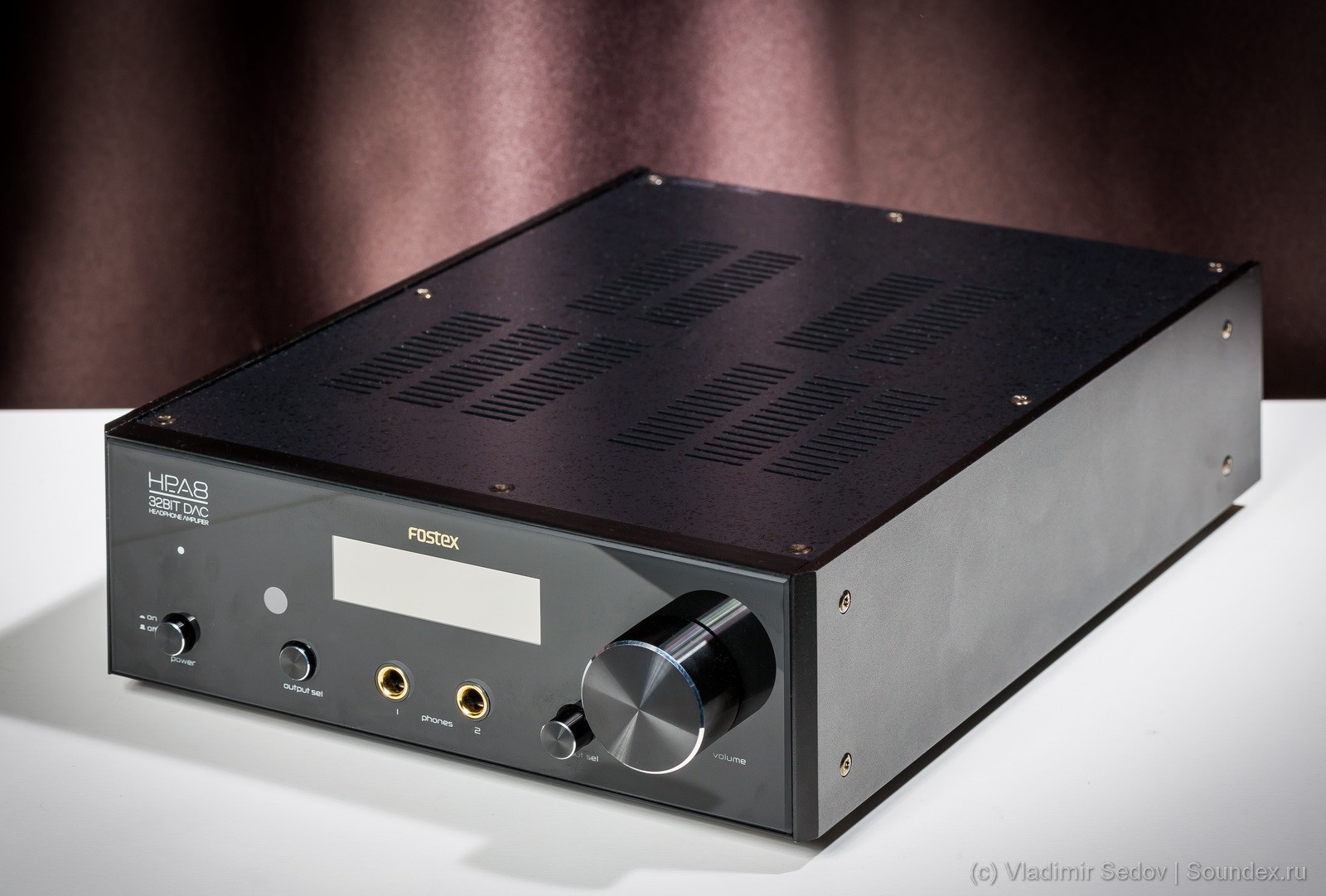
The impressions of the audition:
USB
Тональный баланс в целом ровный, с заметным акцентом в области баса. Бас глубокий, артикуляция хорошая. Сцена непрерывна, и на тестовых записях выходит за пределы базы громкоговорителей. Пространство и воздух сцены передаются хорошо. Детальность в целом высокая. Микро и макродинамика -хорошо. Атака — хорошо. Фокусировка и локализация в горизонтальной плоскости — хорошо. В вертикальной плоскости — хорошо. Высота расположения инструментов практически соответствует натуральной. Звуковые образы не ассоциируются с АС. Звучание на малых уровнях хорошее, тембры инструментов достоверны.
SPDIF
В целом звучание устройства в данном подключении похоже на подключение по USB, с некоторыми, однако, ухудшениями в части артикуляции баса и пространственных характеристик звучания.
Characteristics:
|
Model name |
Fostex HP-A8 |
|
Manufacturer's website |
fostexinternational.com |
|
Approximate cost |
58-60 тысяч рублей |
|
Chip |
AK4399 |
|
Key Technologies |
|
|
Overall dimensions |
213 x 78 x 314 mm |
|
Weight |
3.75 kg
|
North Star Design Supremo
The Italian company North Star Design was founded at the end of the 20th century. The first device offered by the new company to the market was the Model 3 digital-to-analogue converter supporting 24-bit/96 kHz audio playback. In the winter of 2015 the company offered a line of three DACs - Impulso, Excelsio and Supremo. The latter represents the highest price category and is the most technologically advanced model in the series.
Like all North Star Design products, the Supremo DAC is made with real Italian elegance. The black metal case with milled front panel looks very stylish. There's nothing superfluous on the front panel - just the power button and two buttons responsible for switching inputs. All the information the user needs is displayed on a beautiful matrix display consisting of two separated blocks in the form of a trapezoidal and parallelepipeda.
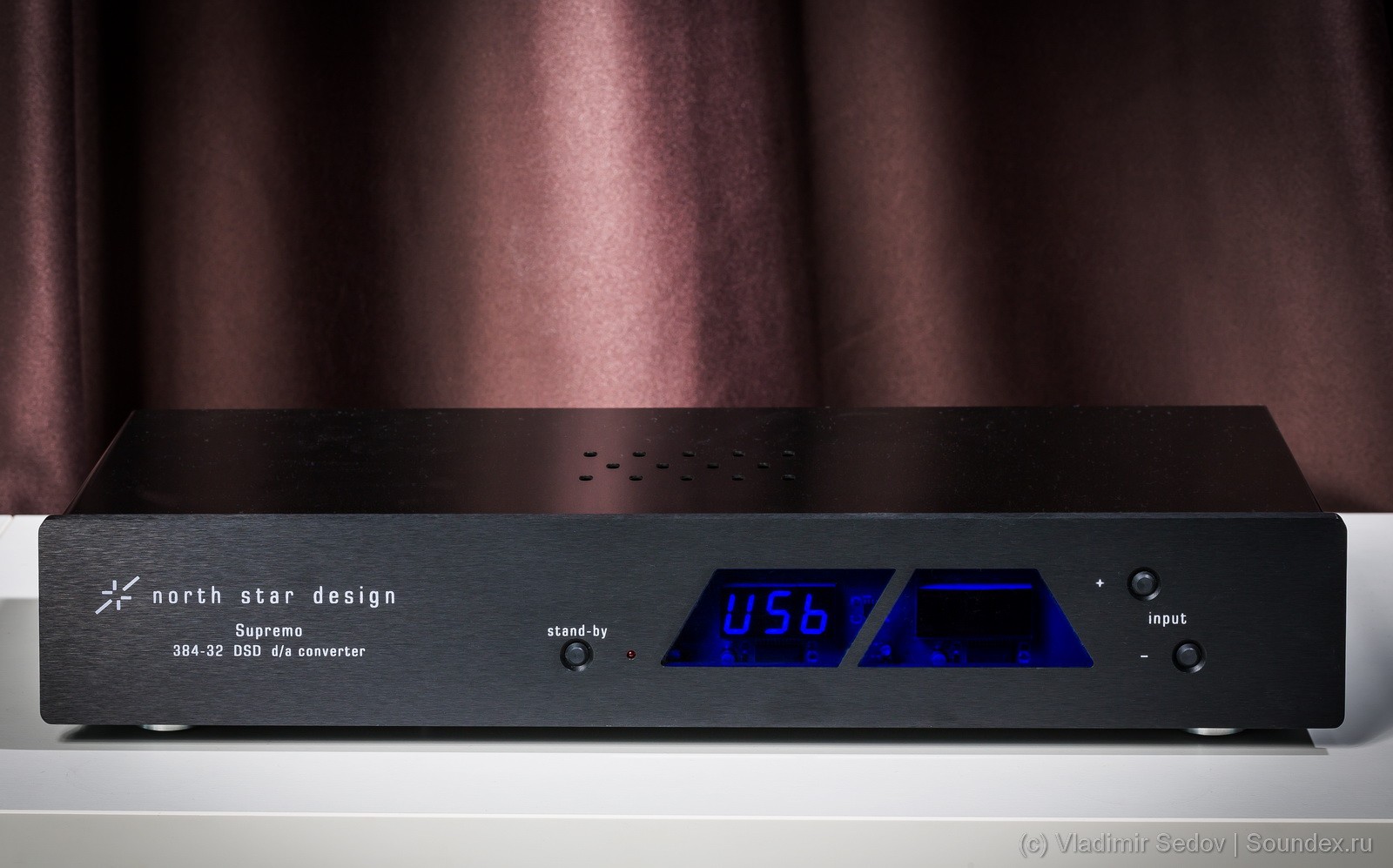
The device has 7 digital inputs, including 4 SPDIF inputs (2 x RCA and 2 x Toslink), one AES/EBU XLR, one USB 2.0 and an I2S interface. The output signal is fed to analogue outputs: balanced with gold-plated Neutrik connectors and unbalanced with WBT NextGen connectors.
The converter runs on a pair of advanced ESS Sabre ES9018 chips connected in a double-balance configuration. These chips are well-proven in leading Hi-End brand top devices, providing high fidelity sound with minimal distortion. Additionally, the user is offered the option to select from the settings menu digital signal filtering modes and the absolute phase. The characteristics of the chips allow to minimize jitter levels, and almost complete suppression of jitter provides a loop of FATH.
North Star Design Supremo is designed for efficient work with high-resolution music files. Its asynchronous USB 2.0 port supports PCM up to 384 kHz / 32 bits, as well as a DSD stream from 2.8 to 5.6 Mbit / sec. The same features have an I2S interface. Coaxial SPDIF inputs are isolated using a pulse transformer.
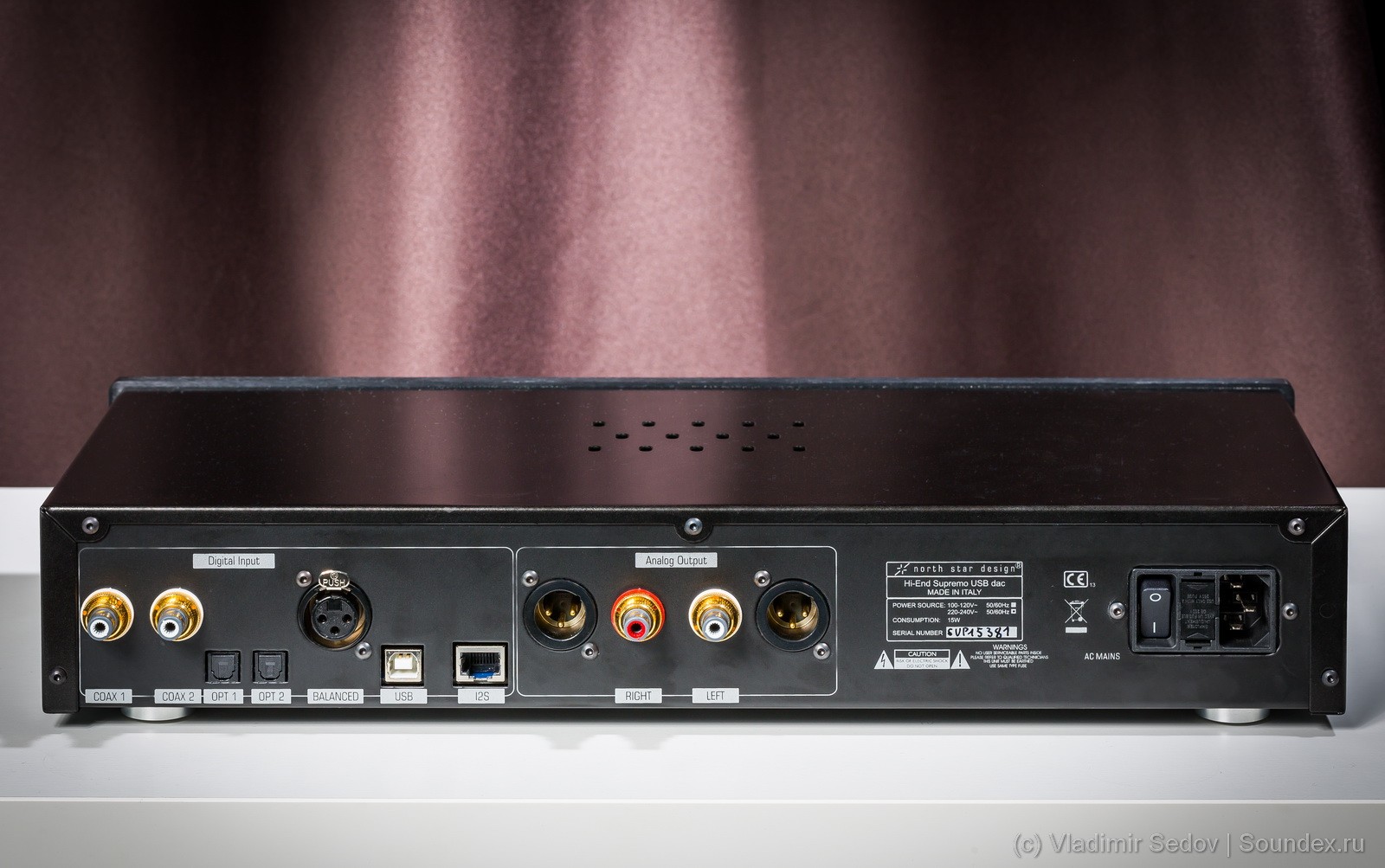
The analogue path is based on discrete low noise transistors, capacitors with dielectric polymer material and precision transistors. All components are selected with maximum precision in their characteristics. The analogue path is grounded by a "star" using separate earth buses for each channel. Given the significant influence of the power circuit on sound quality, special attention has been paid to its construction by the manufacturer. The analogue and digital paths are powered by separate toroids.
The North Star Design Supremo digital to analogue converter is an effective audiophile-quality device for playing music files from your computer's hard drive. It can be connected to a PC on a variety of platforms. The device can be connected to computers running Apple OSx or Linux without drivers. ASIO is used to connect the device to your Windows computer. North Star Design Supremo software updates can be performed when connected to the computer via USB interface.
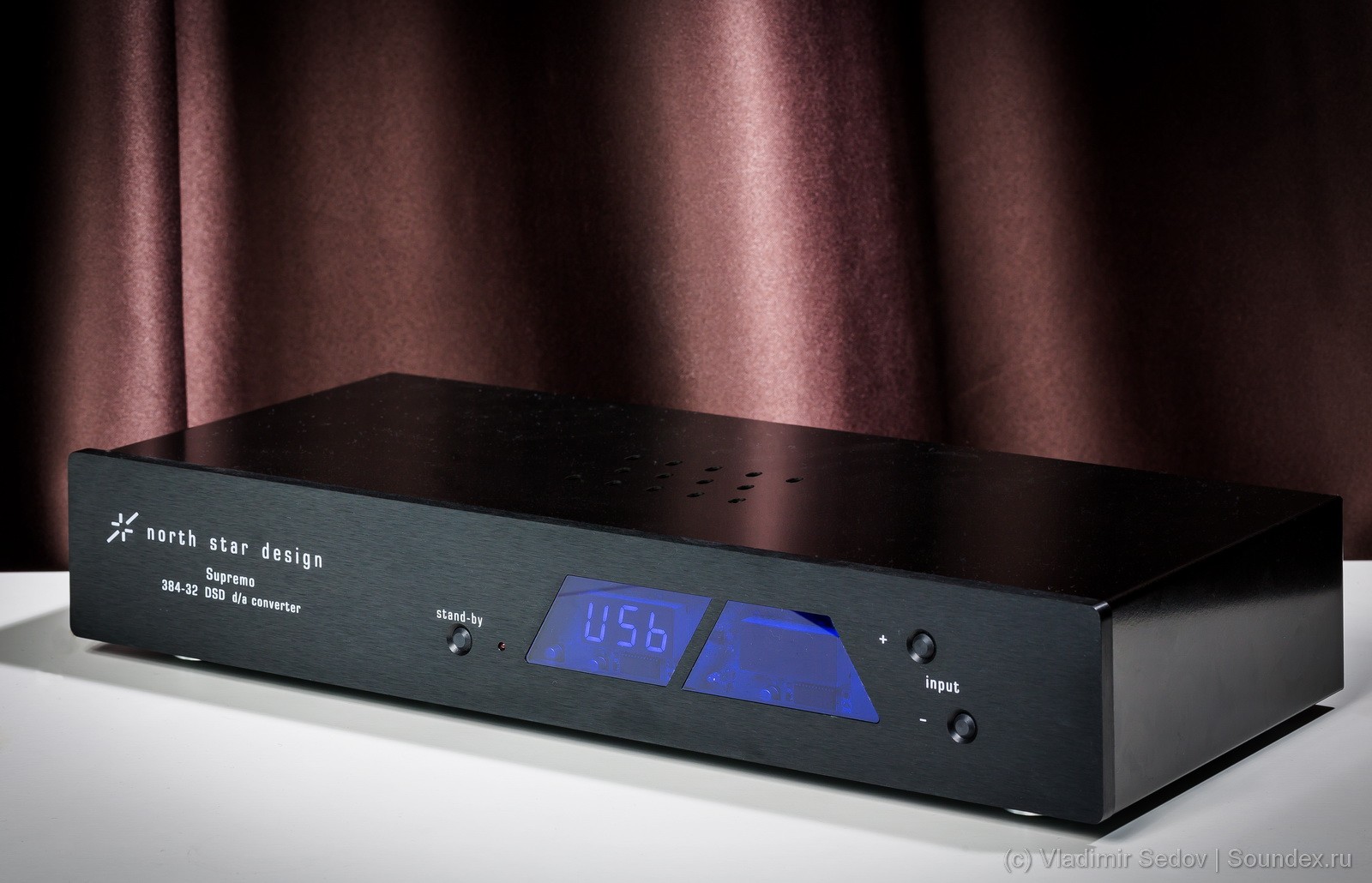
The impressions of the audition:
USB
the tonal balance is even. the bass is deep, well articulated. the scene is continuous, and, on the test recordings, it is distinctly out of the loudspeaker base. the scene space and air are transmitted well. the detail is high, but not excessive. micro and macro dynamics are good. the attack is good. focusing and localization in the horizontal plane is good. in the vertical plane is good. the height of the instruments almost corresponds to the natural one. sound images are not in any way associated with asce sound at low levels is good, t .
SPDIF
Sound retains the basic features of USB connectivity, with some improvements in micro/macro dynamics and spatial sound characteristics (localization and focus).
Characteristics:
|
Model name |
North Star Design Supremo |
|
Manufacturer's website |
northstar.it |
|
Approximate cost |
162 thousand rubles |
|
Chip |
ESS Sabre ES9018 |
|
Key Technologies |
|
|
Overall dimensions |
435 x 70 x 170 mm |
|
Weight |
6.5 kg
|
OPPO HA-1
China's OPPO Digital is one of the most ambitious manufacturers of today's Hi-Fi industry and has quickly gained success among audiophiles, with the main expansion in the demanding American market. Recently, the company introduced a new device OPPO HA-1, combining DAC, preamplifier and headphone amplifier.
The OPPO HA-1 looks very spectacular in an aluminum housing that can be displayed in black or silver, with a thick front panel with large and ergonomic controls and a beautiful 4.3-inch display that can display the traditional volumeter, the modern range of sound frequencies, as well as detailed technical information about the audio signal.
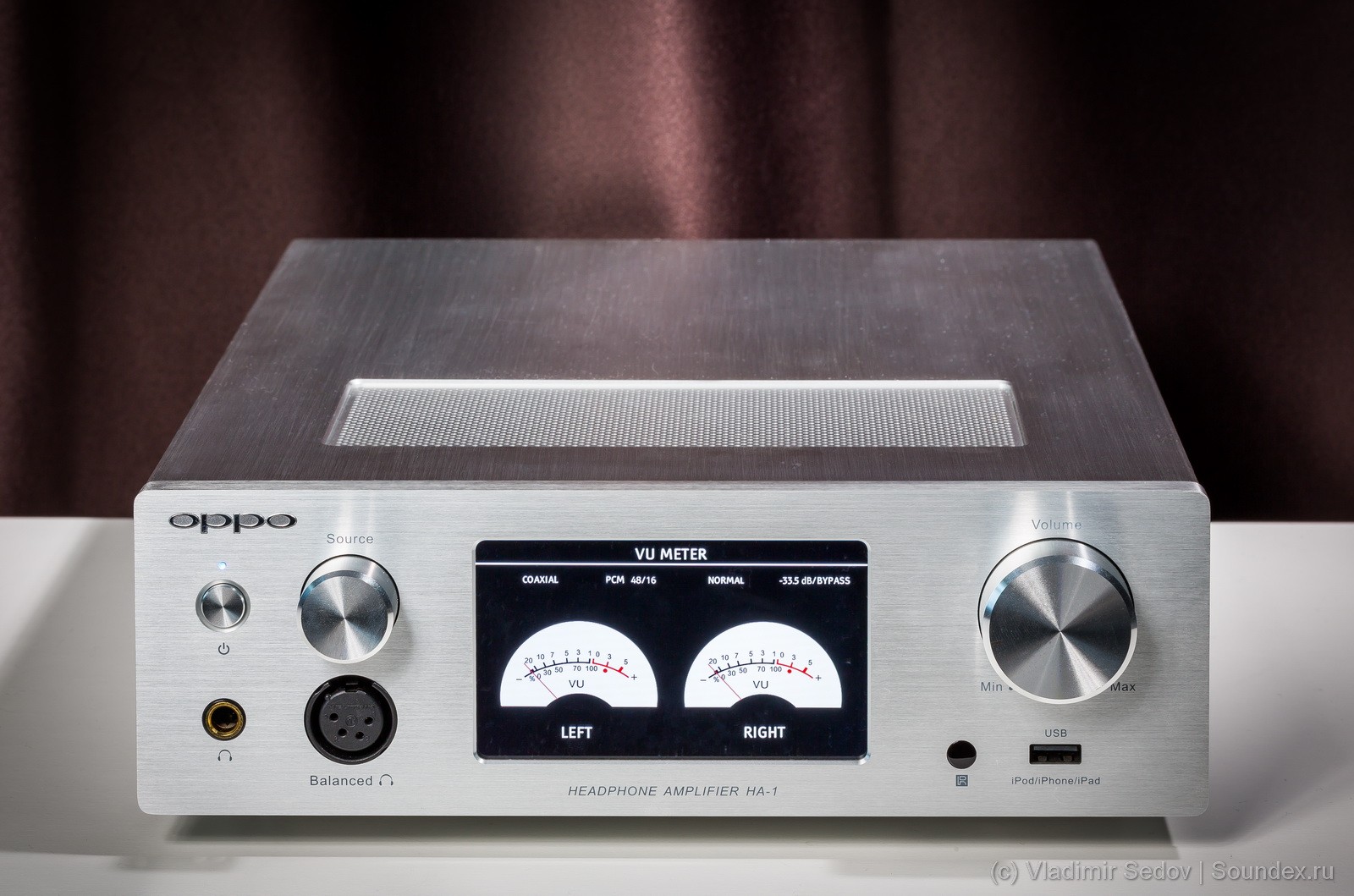
Switching is performed using a wide range of digital inputs (coaxial, optical, AES/EBU balance and asynchronous USB). 4-pin XLR balance input or 1/4 inch headphone jack is available. RCA and XLR line analogue inputs and outputs are also available.
The digital-to-analog conversion to OPPO HA-1 is carried out by the advanced ESS Sabre ES9018 chip, which supports high resolution audio playback, including PCM up to 384 kHz 32-bit resolution and DSD up to CD 256x sampling rate. The circuitry is fully balanced. Analog volume control is provided by means of a discrete motorized knob, which is easy to control both manually and remotely, while maintaining high sound quality at low volume levels.
A large number of digital inputs, including PCM, DSD64 and DSD128-supported asynchronous USB, allow the OPPO HA-1 to be connected to a wide variety of devices.
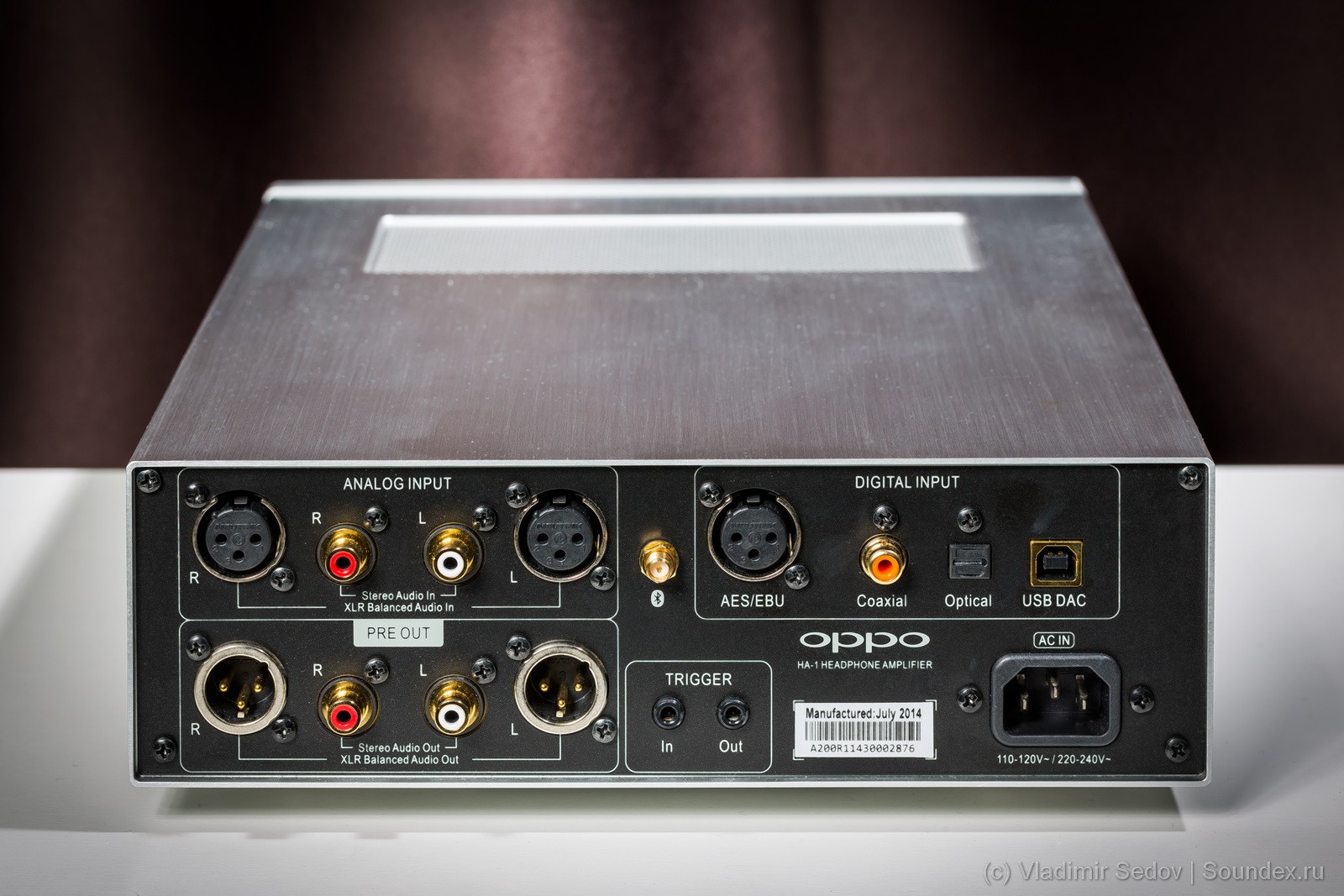
The digital-to-analog converter is powered by a proprietary toroidal transformer, which has proven itself in the manufacturer's devices. The transformer provides the electronic components with sufficient energy resources, while its design allows for maximum purity of sound.
The OPPO HA-1 efficiently handles the stereo preamplifier function, providing high quality sound from any digital source, as well as being a headphone amplifier that is widely used by many users. This is not surprising, as the headphone amplifier is fully balanced and built on 12 Sanken bipolar transistors. It provides confident control over almost any modern Class A headphone.
For mobile device users, the OPPO HA-1's Bluetooth function with AptX codec will be very convenient, allowing wireless playback of content on a mobile device, as well as smartphone or tablet can be easily connected to the OPPO HA-1 via USB input.
Included with the device is a functional remote control, which allows you to control virtually all key parameters of the device. You can also use the remote control to adjust the volume, switch inputs, turn the sound on and off, adjust the brightness level of the display. All control functions are also available directly on your smartphone or tablet using a special application.
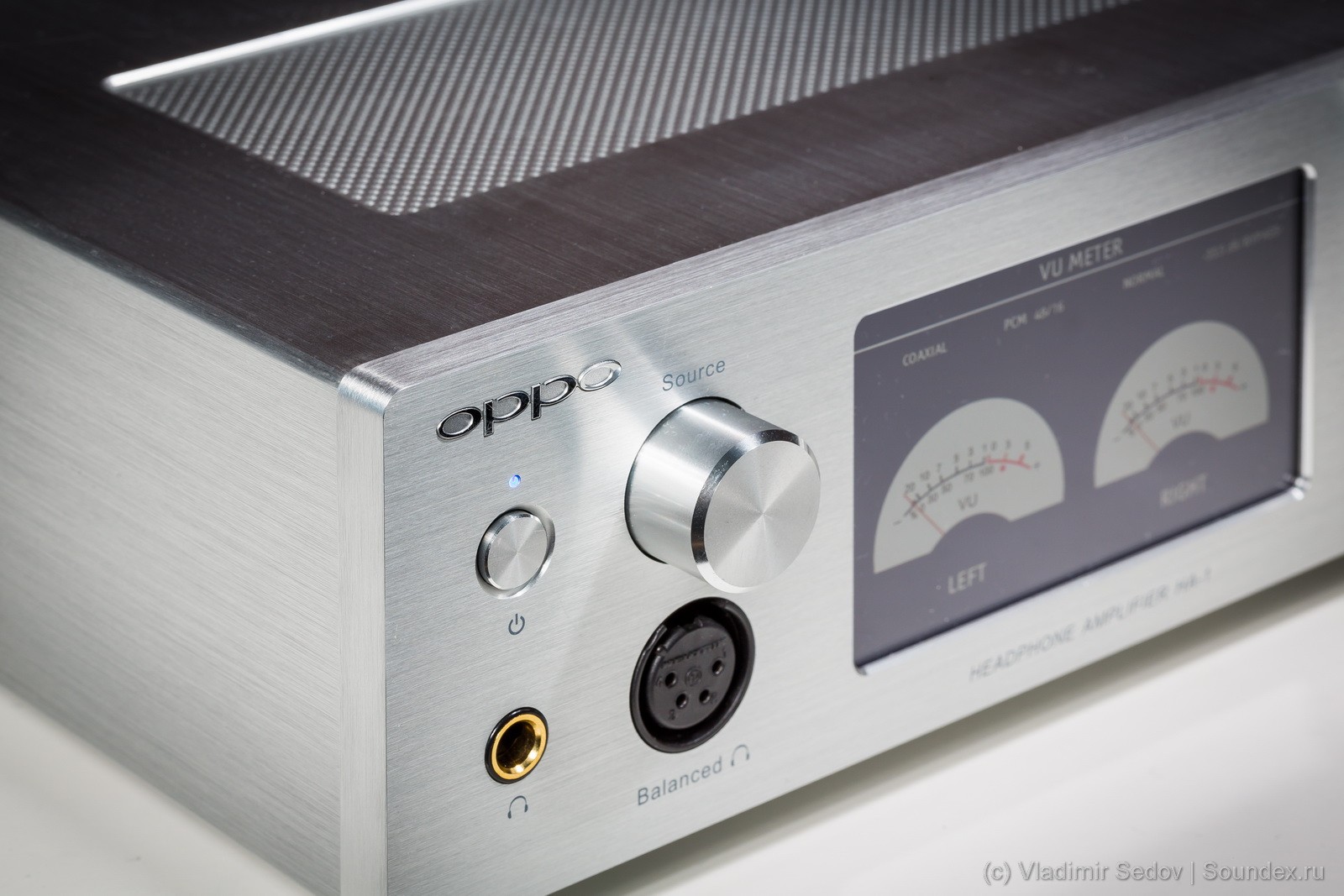
The impressions of the audition:
USB
The tonal balance is generally flat, with a slight accent in the bass area. The bass is deep, the articulation is satisfactory. The scene is continuous, and, on the test recordings, the space and air in the scene are transmitted well. The detail is high. Micro and macro dynamics are good. The attack is good. The focus and localization in the horizontal plane is good. In the vertical plane is good. The height of the instruments corresponds to the natural one. Sound images are not associated with the speaker. Sound at low levels is good, t. Sound at low levels is good.
SPDIF
Sound retains the basic features of USB connectivity, with some improvements in bass articulation and spatial sound characteristics (localization and focus).
Characteristics:
|
Model name |
OPPO HA-1 |
|
Manufacturer's website |
oppodigital.com |
|
Approximate cost |
80 thousand rubles |
|
Chip |
ESS Sabre ES9018 |
|
Key Technologies |
|
|
Overall dimensions |
254 x 80 x 333 mm |
|
Weight |
5.9 kg
|
HYTOGI
In general, all the devices have demonstrated a high level of sound quality. The differences noted by the FSQ method are not the difference in the class of the tested DACs, but rather the high resolution of the method. The spread of points, and therefore the difference in the sound of DACs, was not more than 10%. For many people this difference can be absolutely insignificant, but in a carefully selected and well studied system, for those who strive for the ideal, this difference can be quite tangible.
The results of the audition for USB
|
Place |
Model |
Price |
No DAC |
Scores |
|
1 |
Cary Audio DAC100 |
195 000,00р. |
DAC No. 6 |
73,00 |
|
2 |
Burson Audio Conductor Virtuoso 9018 |
102 500,00р. |
DAC No. 8 |
71,33 |
|
3 |
ASUS Xonar Essence III |
167 500,00р. |
DAC No. 7 |
71,00 |
|
4 |
North Star Design Supremo |
162 000,00р. |
DAC No. 5 |
70,33 |
|
5 |
Densen DenDAC 50 |
250 000,00р. |
DAC No 4 |
69,50 |
|
6 |
OPPO HA-1. |
79 990,00р. |
DAC No 2 |
68,00 |
|
7 |
Chord 2Qute |
100 000,00р. |
DAC No. 1 |
66,33 |
|
8 |
Fostex HP-A8 |
59 000,00р. |
DAC No. 3 |
65,00 |
If you look closely at the figures, in general, we can conclude that the quality of DAC directly depends on the price. The exceptions in this case are Burson Audio Conductor Virtuoso 9018, which at its not very high price took second place, and Densen DenDAC and Chord 2Qute, which at its price were slightly lower than their classmates.
USB audio leaders include Cary Audio DAC100, Burson Audio Conductor Virtuoso 9018 and ASUS Xonar Essence III.
The results of the audition for SPDIF
|
Place |
Model |
Price |
No DAC |
Scores |
|
1 |
Densen DenDAC 50 |
250 000,00р. |
DAC No 4 |
77,92 |
|
2 |
Burson Audio Conductor Virtuoso 9018 |
102 500,00р. |
DAC No. 8 |
76,92 |
|
3 |
North Star Design Supremo |
162 000,00р. |
DAC No. 5 |
73,93 |
|
4 |
Cary Audio DAC100 |
195 000,00р. |
DAC No. 6 |
72,93 |
|
5 |
Chord 2Qute |
100 000,00р. |
DAC No. 1 |
72,93 |
|
6 |
OPPO HA-1. |
79 990,00р. |
DAC No 2 |
68,93 |
|
7 |
ASUS Essence III |
167 500,00р. |
DAC No. 7 |
67,93 |
|
8 |
Fostex HP-A8 |
59 000,00р. |
DAC No. 3 |
65,93 |
With a classic SPDIF connection, the picture changes a bit. Suddenly Densen DenDAC comes out in first place. Apparently, USB for him is just a tribute to fashion. Surprisingly, all DACs on SPDIF sound better than on USB. Only Asus Essence III has dropped from 3 to 7 places. It is quite logical that the DAC from IT company is much better working on USB than on SPDIF. At the same time, relatively inexpensive DAC Burson Audio Conductor Virtuoso 9018 remained in second place. The rest of DACs are again placed at their price.
Thus, the SPDIF sound leaders have become Densen DenDAC 50, Burson Audio Conductor Virtuoso 9018 and North Star Design Supremo.
Price/quality (based on points)
|
Place |
Model |
Price |
No DAC |
Price by points |
|
1 |
Burson Audio Conductor Virtuoso 9018 |
102 500 р. |
DAC No. 8 |
146 117 р. |
|
2 |
Densen DenDAC 50 |
250 000 р. |
DAC No 4 |
145 238 р. |
|
3 |
Cary Audio DAC100 |
195 000 р. |
DAC No. 6 |
143 933 р. |
|
4 |
North Star Design Supremo |
162 000 р. |
DAC No. 5 |
142 215 р. |
|
5 |
Chord 2Qute |
100 000 р. |
DAC No. 1 |
137 224 р. |
|
6 |
ASUS Xonar Essence III |
167 500 р. |
DAC No. 7 |
137 093 р. |
|
7 |
OPPO HA-1. |
79 990 р. |
DAC No 2 |
135 040 р. |
|
8 |
Fostex HP-A8 |
59 000 р. |
DAC No. 3 |
129 125 р. |
Profitable offer
|
|
Model |
Price |
No DAC |
Price by points |
Overpayment |
|
Place |
|||||
|
1 |
Fostex HP-A8 |
59 000 р. |
DAC No. 3 |
129 125 р. |
-54% |
|
2 |
OPPO HA-1 |
79 990 р. |
DAC No 2 |
135 040 р. |
-41% |
|
3 |
Burson Audio Conductor Virtuoso 9018 |
102 500 р. |
DAC No. 8 |
146 117 р. |
-30% |
|
4 |
Chord 2Qute |
100 000 р. |
DAC No. 1 |
137 224 р. |
-27% |
|
5 |
North Star Design Supremo |
162 000 р. |
DAC No. 5 |
142 215 р. |
14% |
|
6 |
ASUS Xonar Essence III |
167 500 р. |
DAC No. 7 |
137 093 р. |
22% |
|
7 |
Cary Audio DAC100 |
195 000 р. |
DAC No. 6 |
143 933 р. |
35% |
|
8 |
Densen DenDAC 50 |
250 000 р. |
DAC No 4 |
145 238 р. |
72% |
In conclusion, we give you a table in which we have arranged the devices in accordance with the calculated cost based on the points received (SPDIF and USB averages), as well as how much we overpay for the proposed sound quality or, conversely, we receive a gift from the manufacturer, based on the ratio of real cost to the cost received by points. It should be borne in mind that in addition to sound quality in the cost can be included additional features or improved design, but in our test we took into account only the quality of sound.
The absolute leaders in sound (SPDIF and USB) were Burson Audio Conductor Virtuoso 9018, Densen DenDac 50, Cary Audio and North Star Design Supremo.
At the same time, all the "kids" Fostex HP-A8, OPPO HA-1 and Chord 2Qute, which we "offended" in this test, since they performed devices much more expensive, at its low cost may well pull up in the class higher. Their real cost is much lower than the cost of their sound! And if the price is important to you, it is worth turning to these DACs. They represent the most advantageous offer, especially for the unsophisticated user.
Burson Audio Conductor Virtuoso 9018 proved to be the best, both in sound and in "not greedy" of the manufacturer.
I would also like to note that starting from the average level, the increase in sound quality lags far behind the increase in cost. to achieve a slight improvement in sound, manufacturers have to make maximum efforts, which then affect the price. so the conclusion is simple - the price / quality ratio is much better for inexpensive devices. with a difference in sound of only 10%, the cost of the cheapest device is 5 times lower than the price of the most expensive device. but whether it is worth paying for such an increase in quality, it is up to everyone to decide.
You can compare the sound of your DACs by yourself with our recordings of Korg MR-1:
DSD:
№1 — https://yadi.sk/d/zw4t7HgTguz2L
#2 WAV: https://yadi.sk/d/HX4L8KnkgwNCQ
№3 — https://yadi.sk/d/sKdNUzc-guz4E
#4 DSF: https://yadi.sk/d/264lpmrbgwNGC
№5 — https://yadi.sk/d/sotvxp9zguz7P
№6 — https://yadi.sk/d/ChvlILb9guz8U
№7 — https://yadi.sk/d/nRygSjvLguz9Z
#8 DSF: https://yadi.sk/d/aES56FtIgwNRy
WAV:
№1 — https://yadi.sk/d/FzXfo11AguzDK
#2 DSF: https://yadi.sk/d/DQ5JEAdDgwN6r
№3 — https://yadi.sk/d/sW1Y5NbXguzDq
#4 WAV: https://yadi.sk/d/_g0Z3XXogwNKV
№5 — https://yadi.sk/d/HZ23ZzqrguzEQ
№6 — https://yadi.sk/d/Hhg1TJGQguzFP
№7 — https://yadi.sk/d/QSHMVCMsguzG6
#8 WAV: https://yadi.sk/d/ApgBVkGwgwNPf
